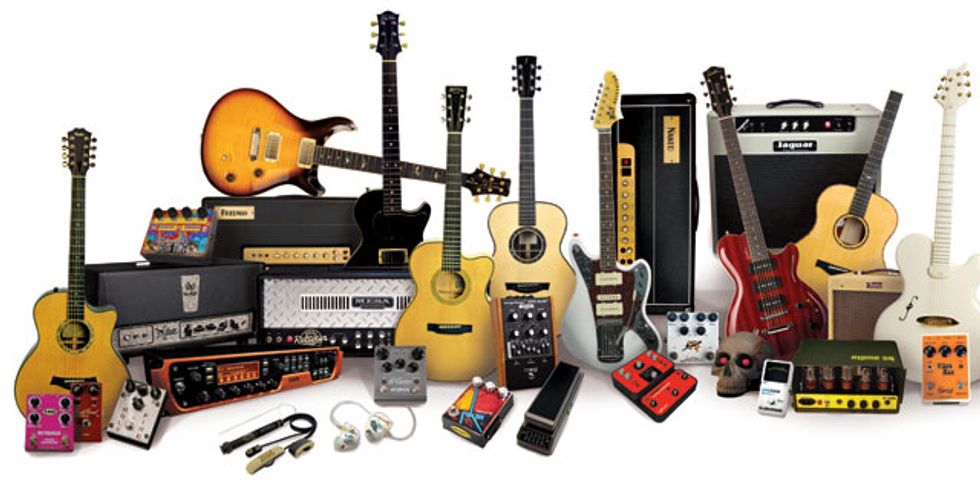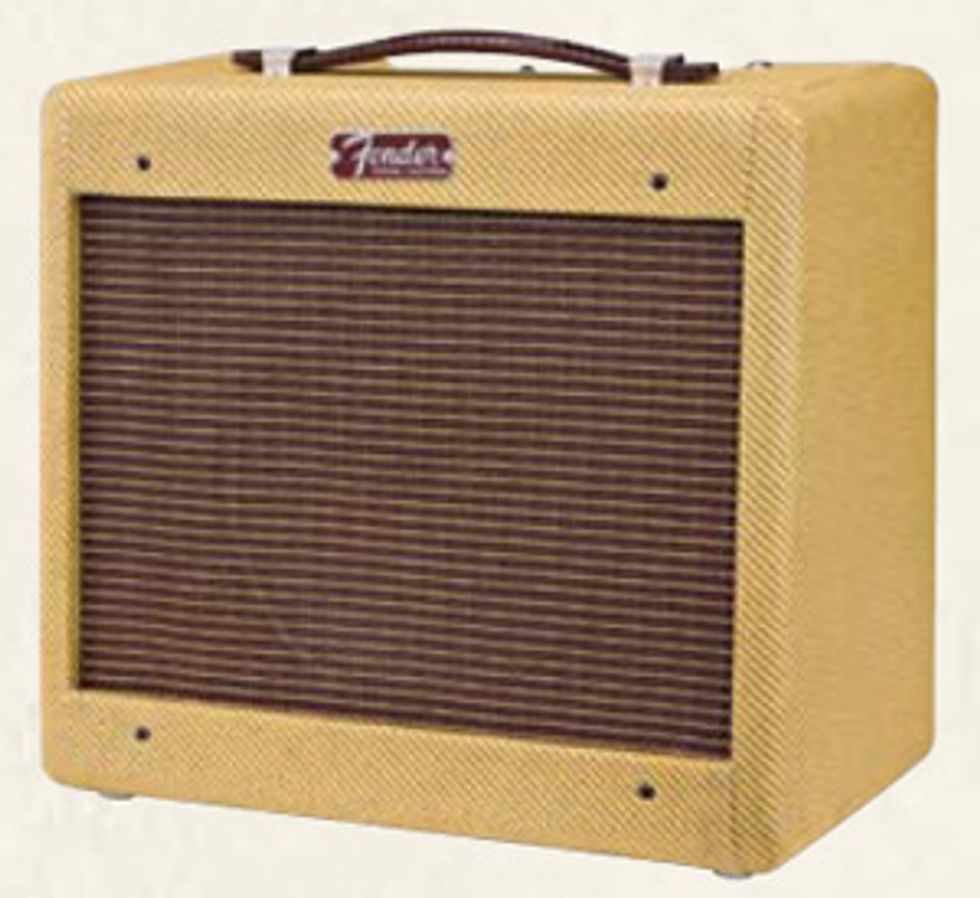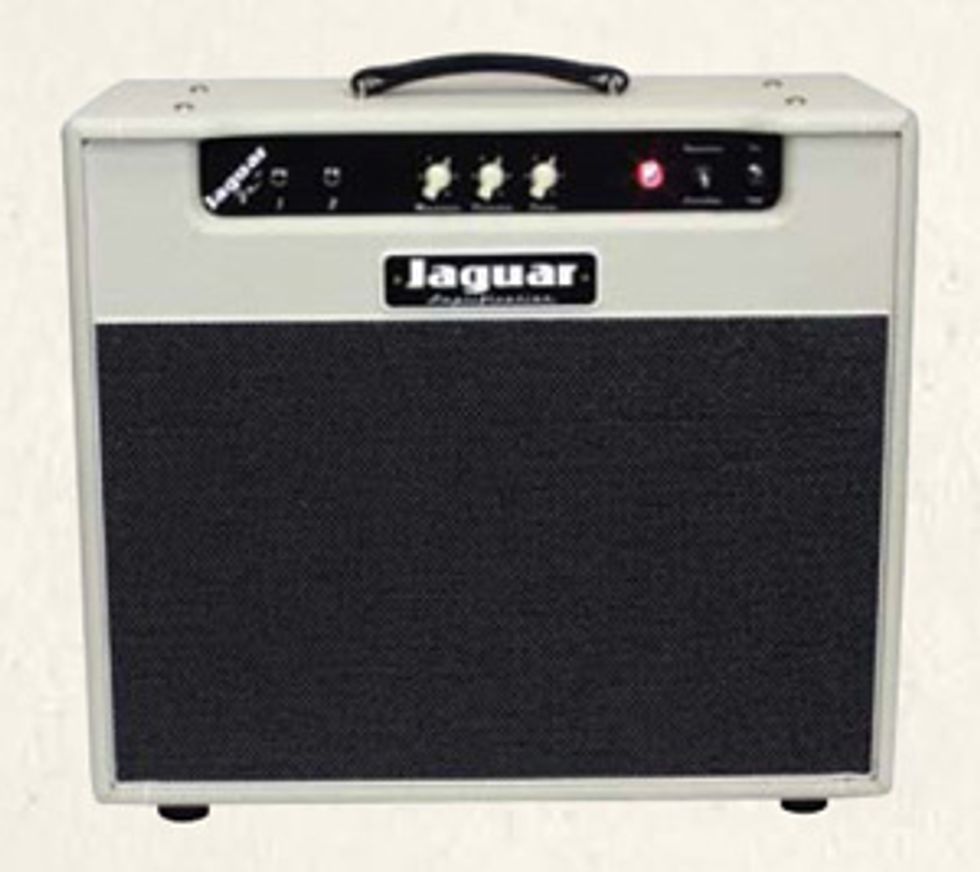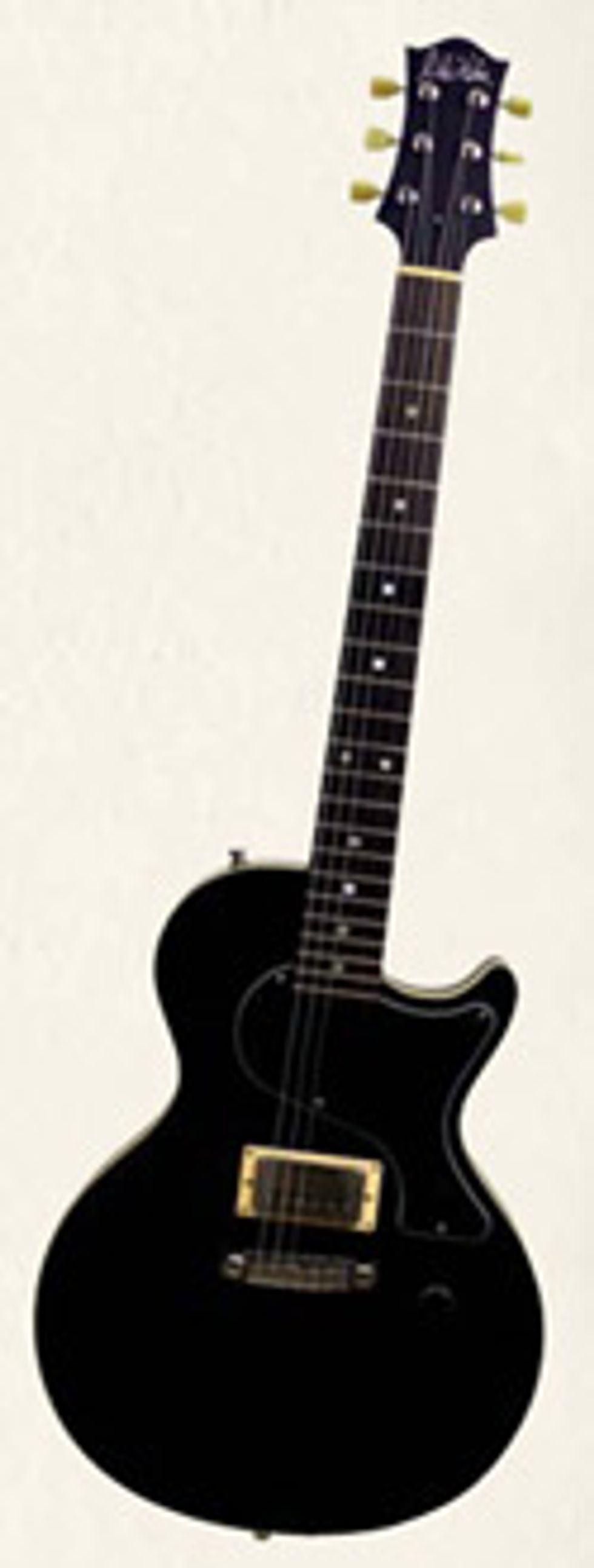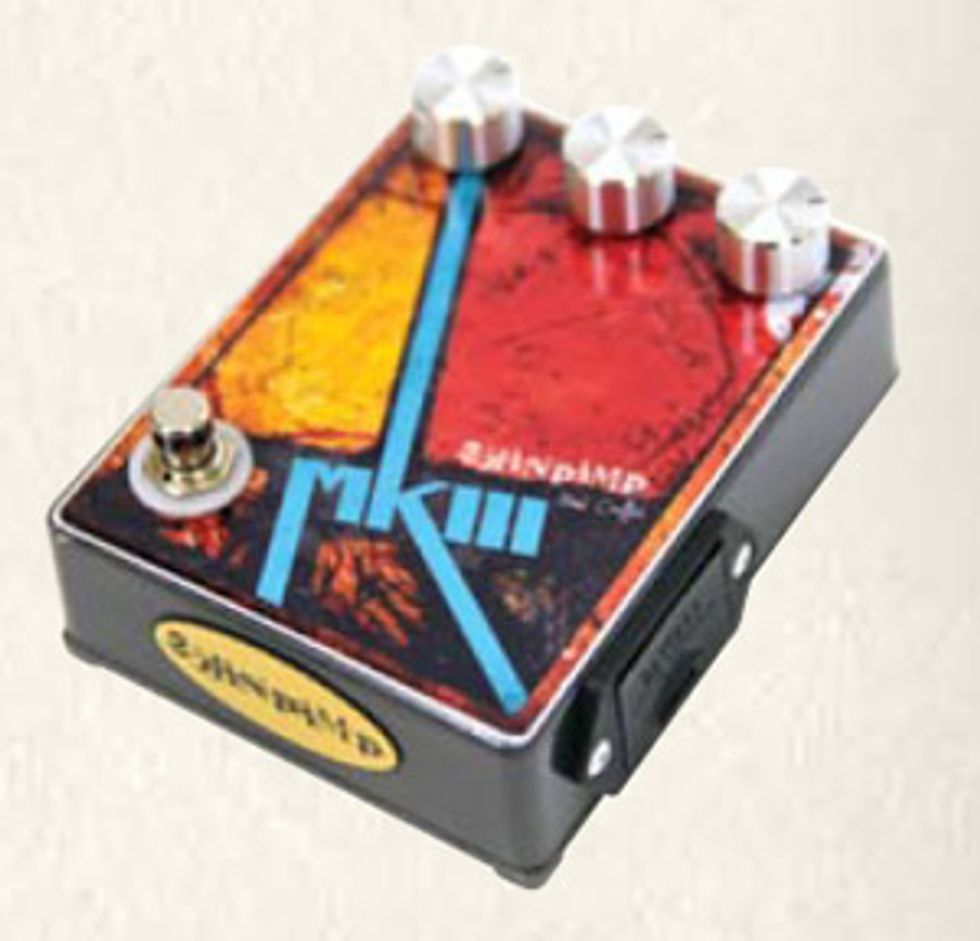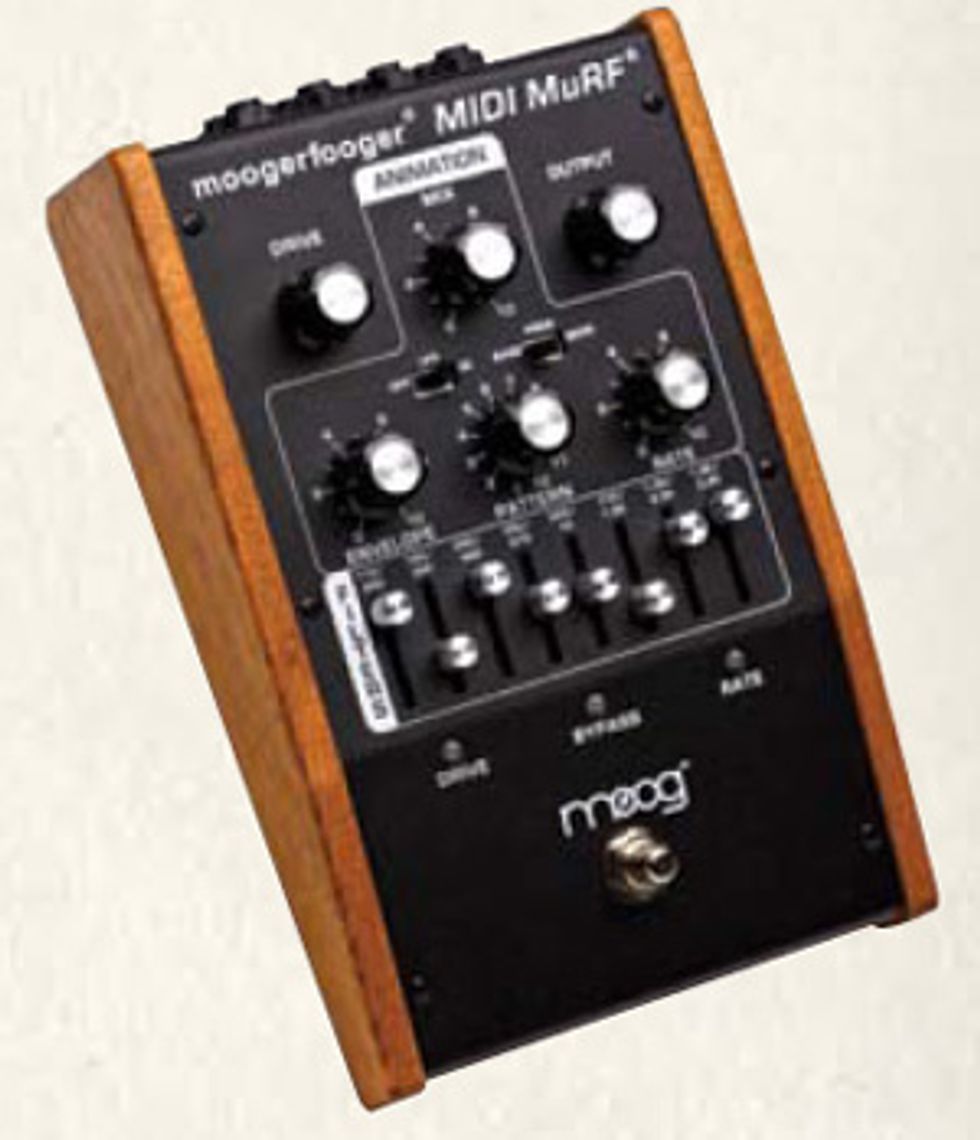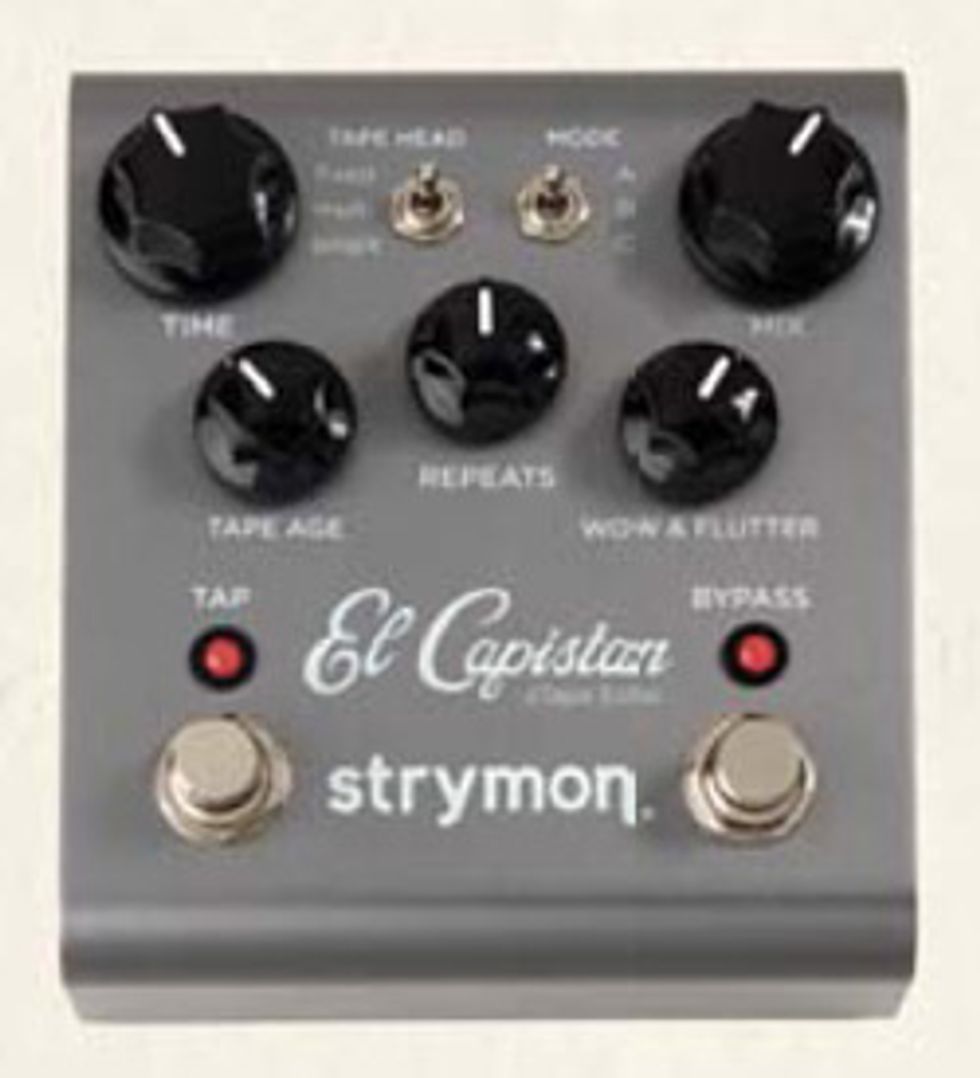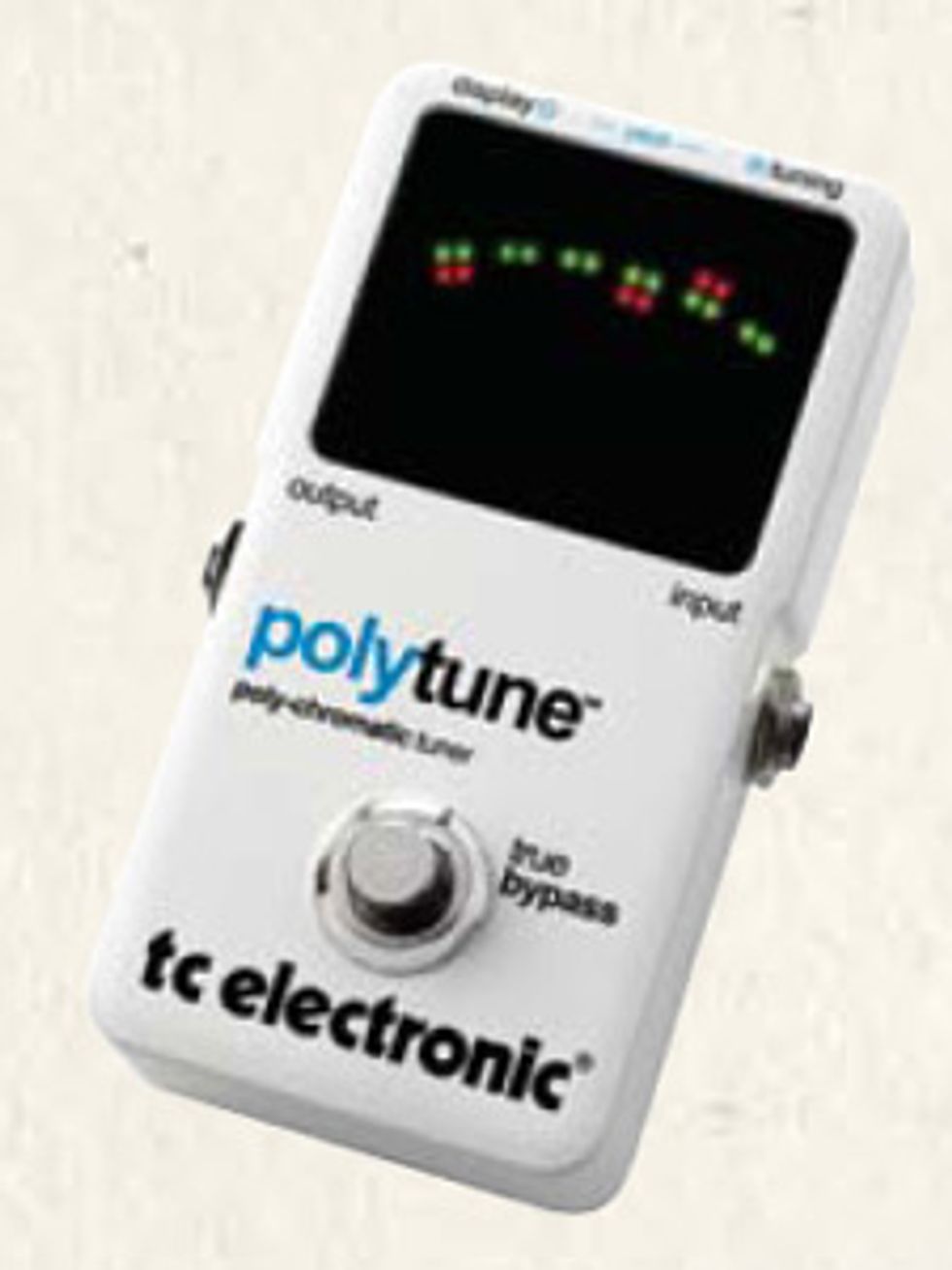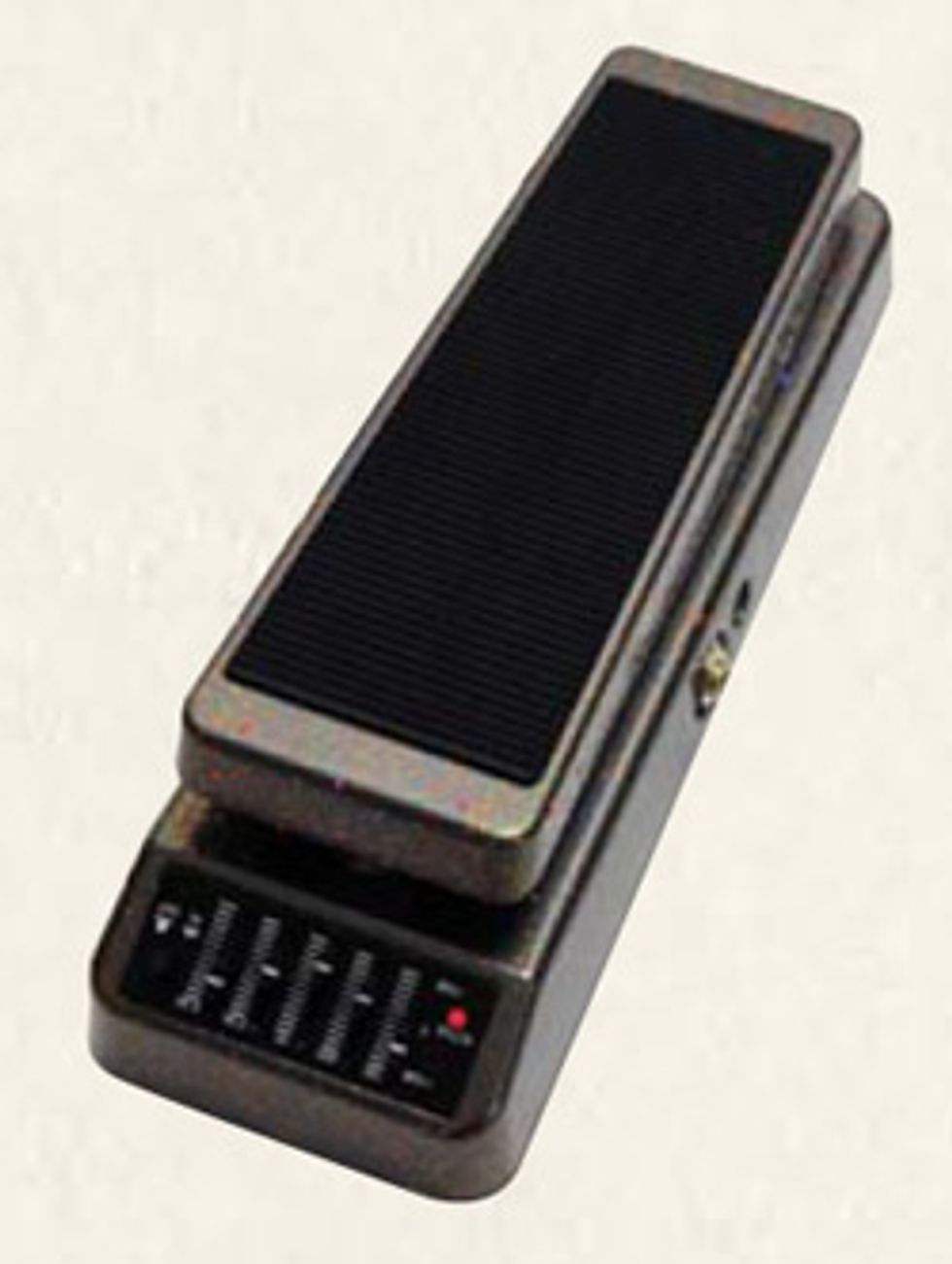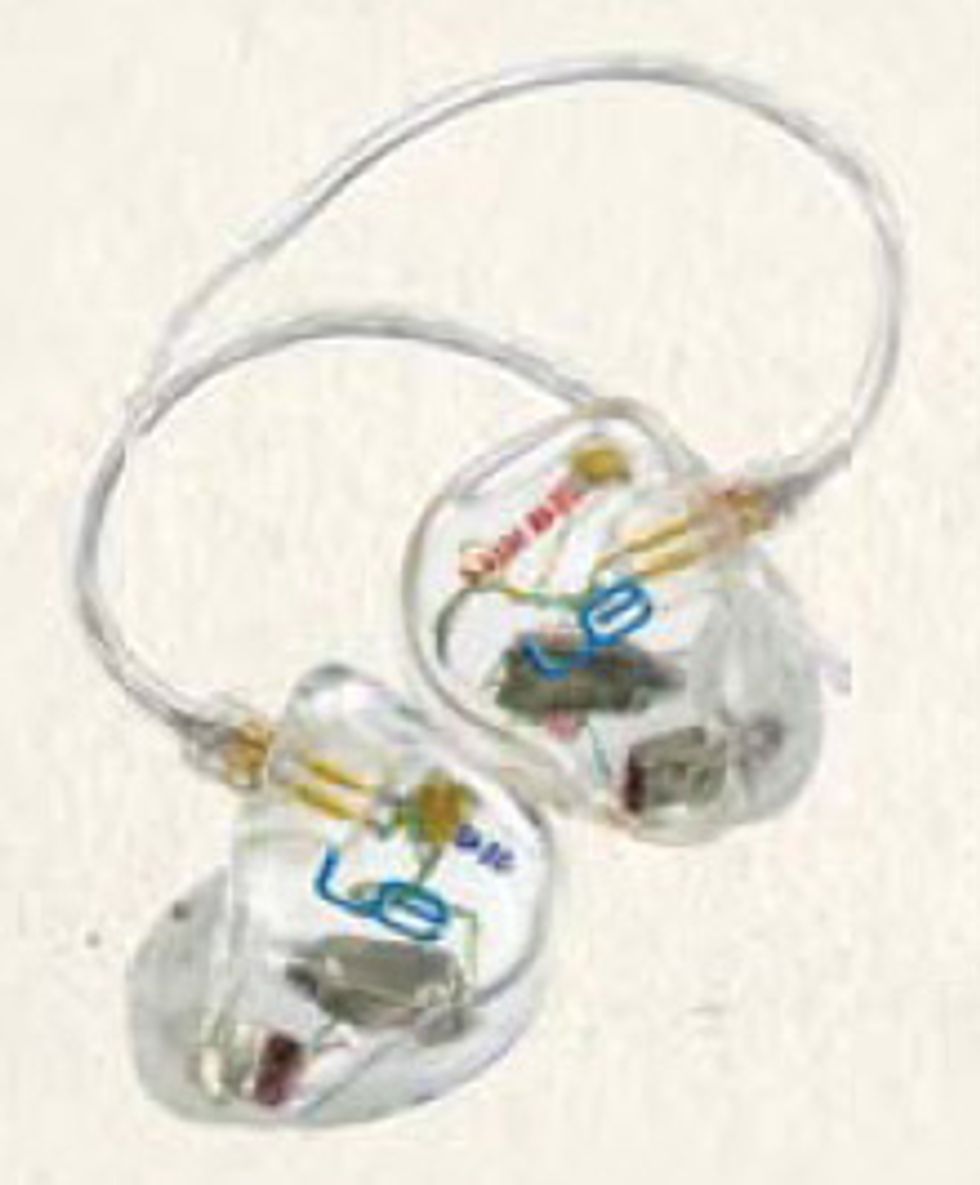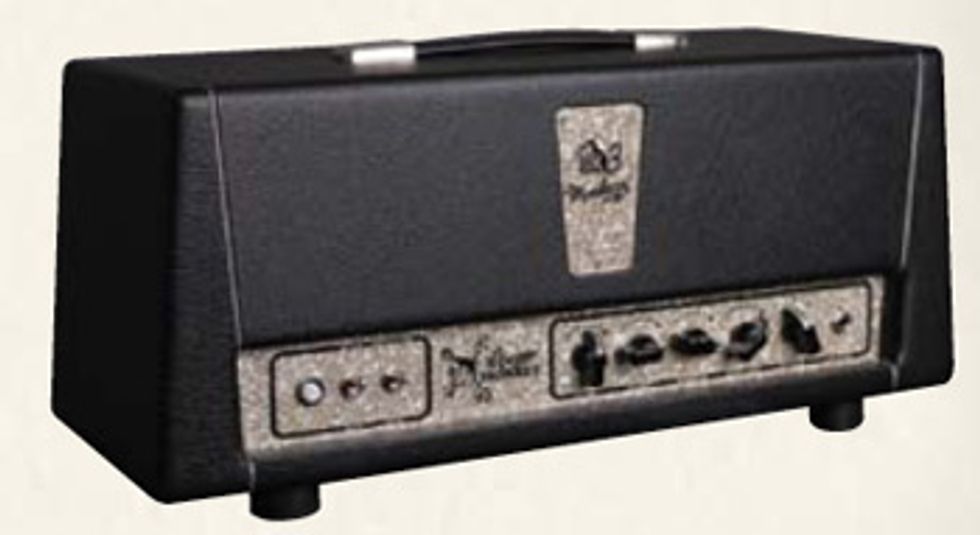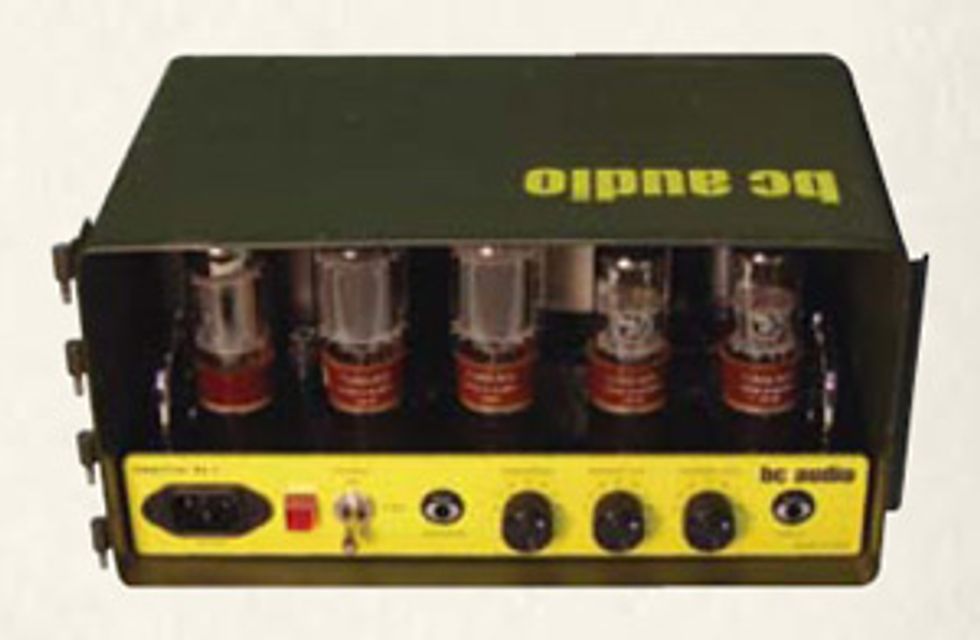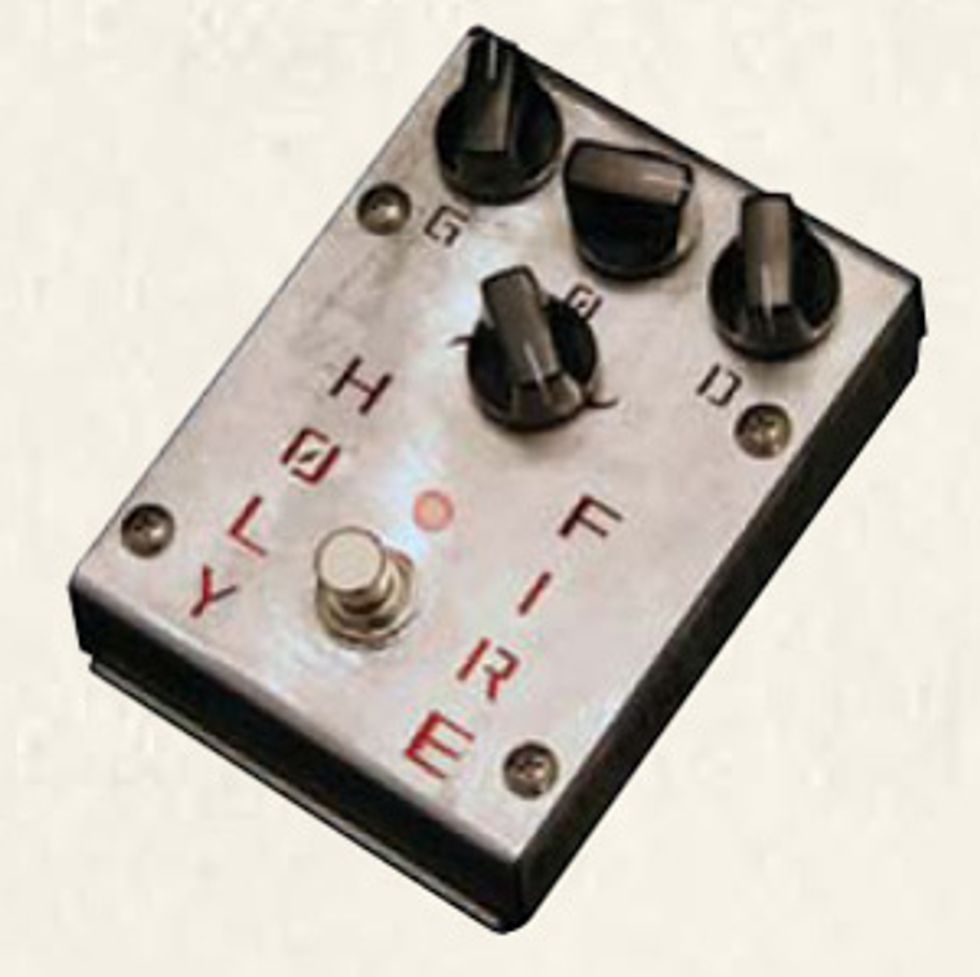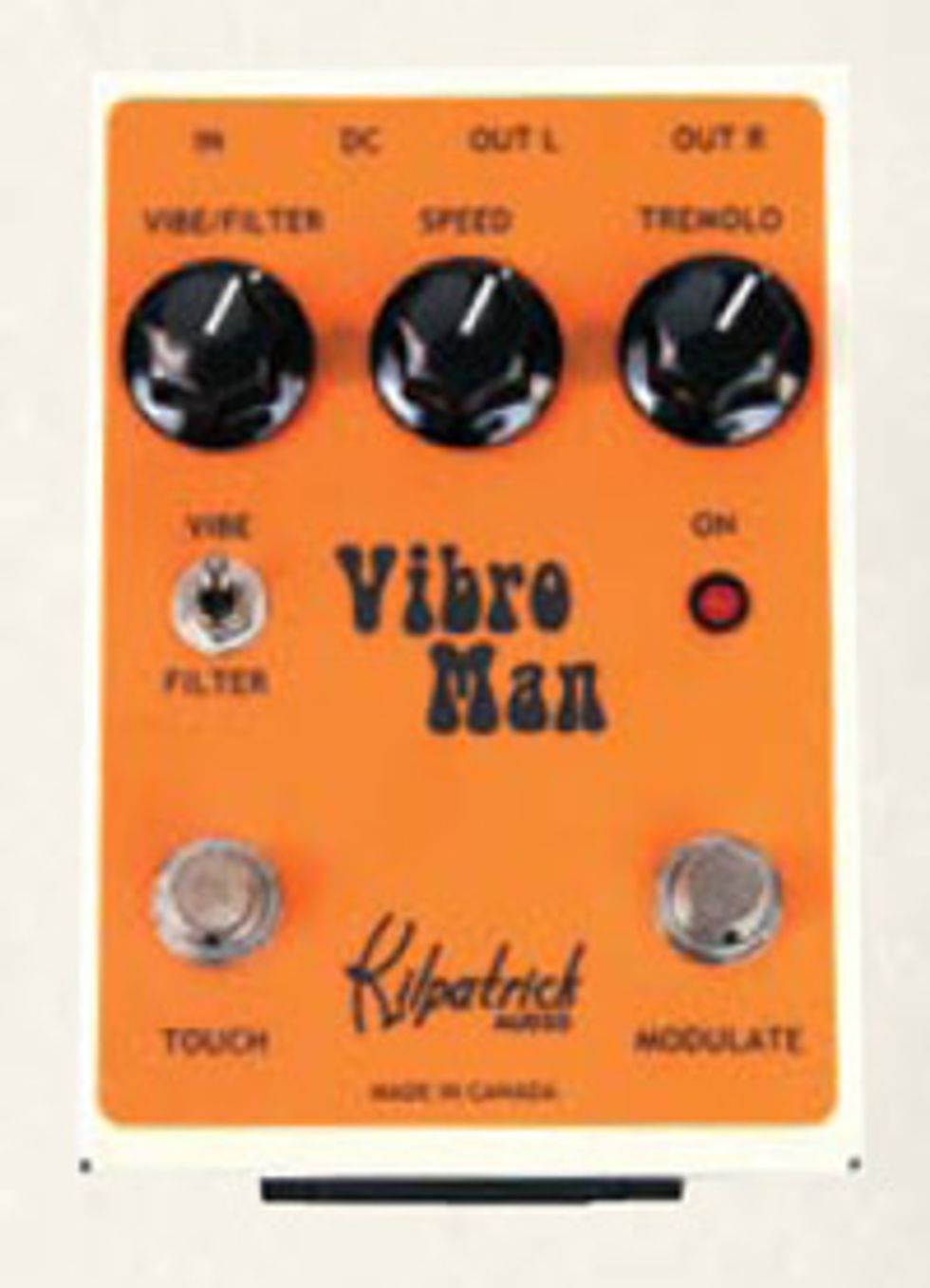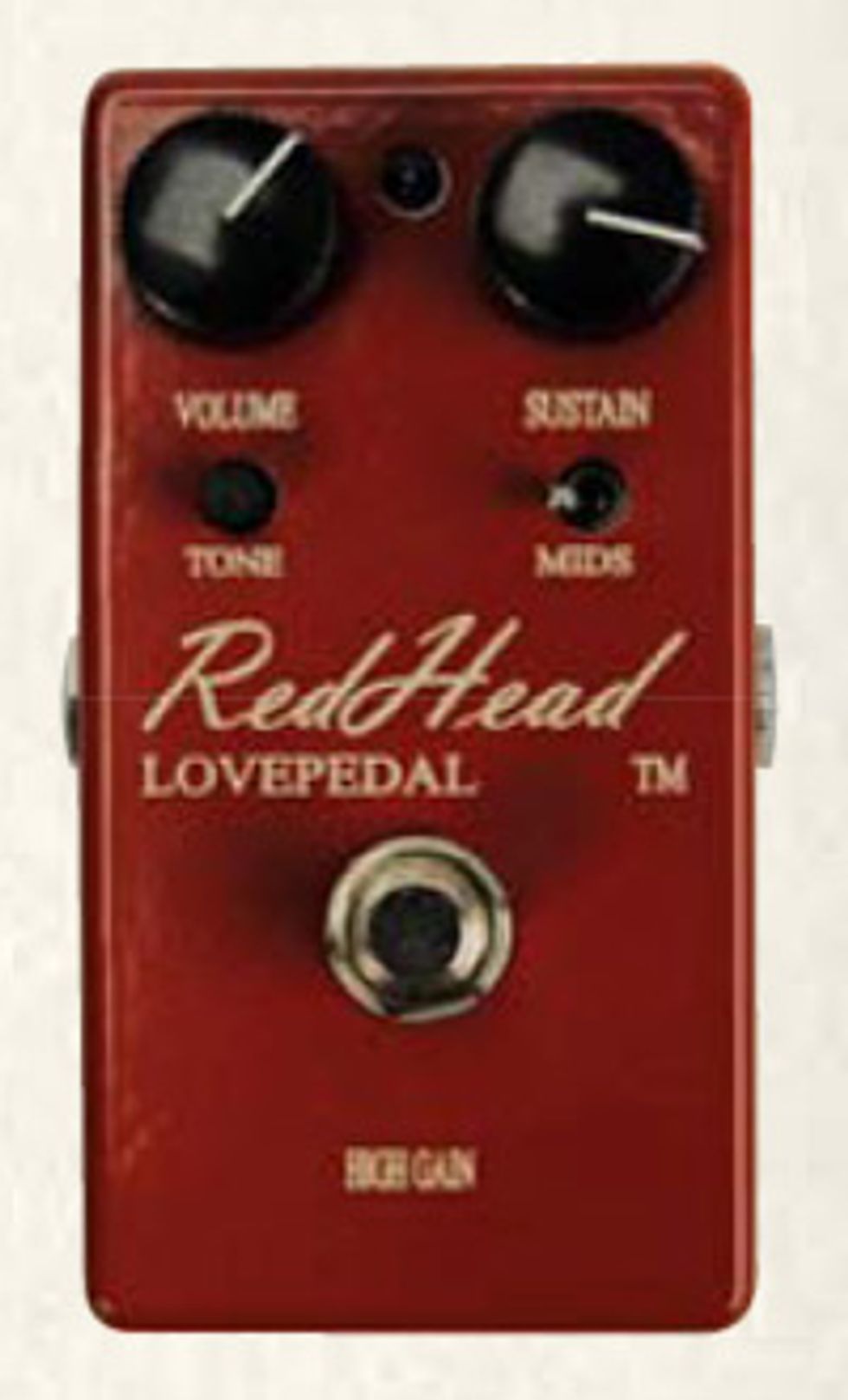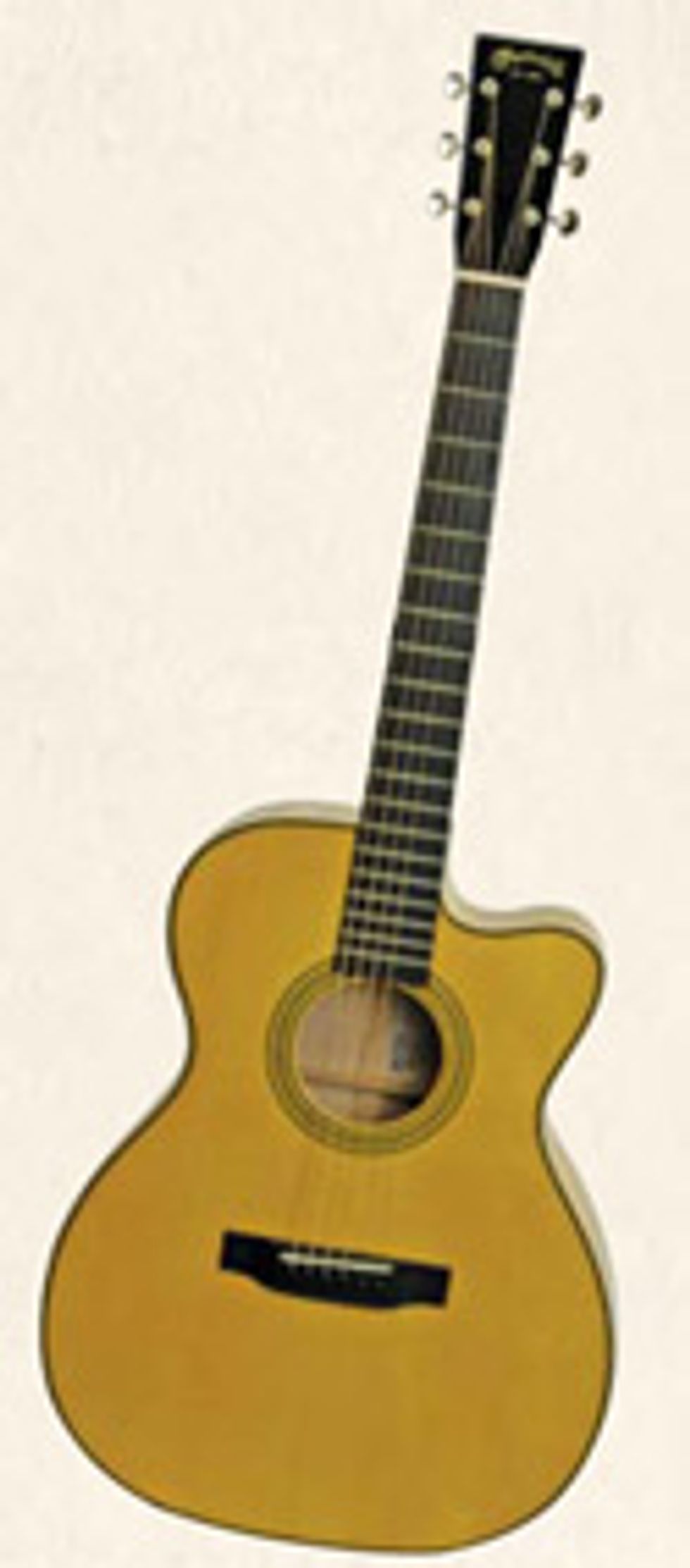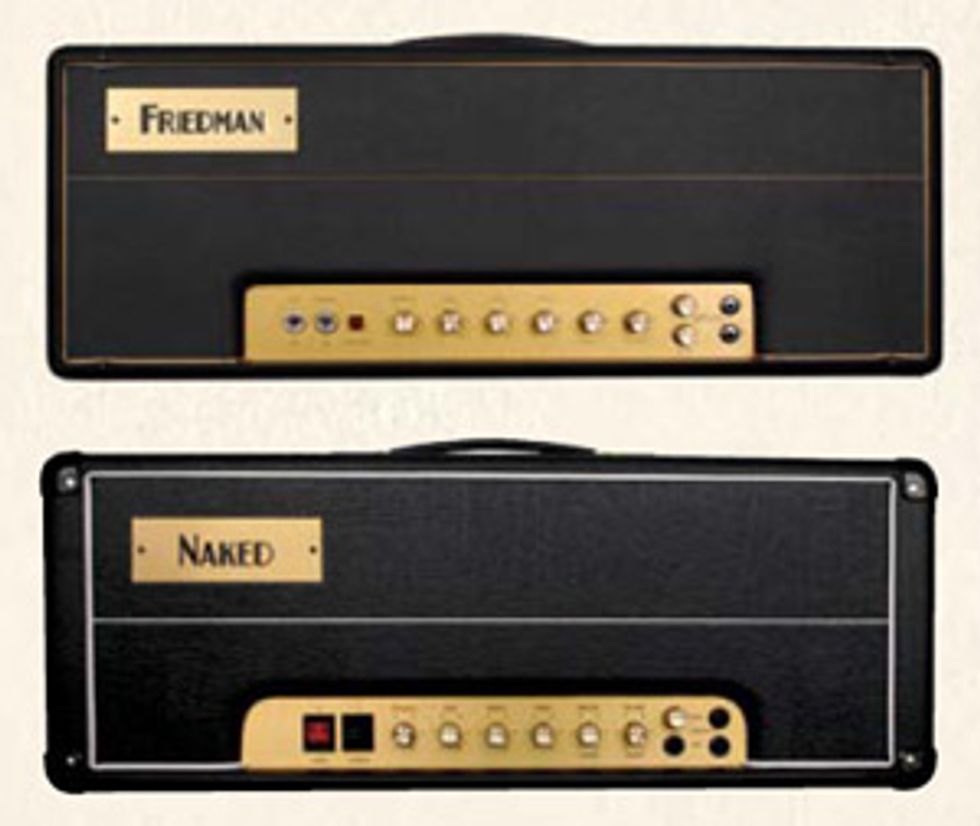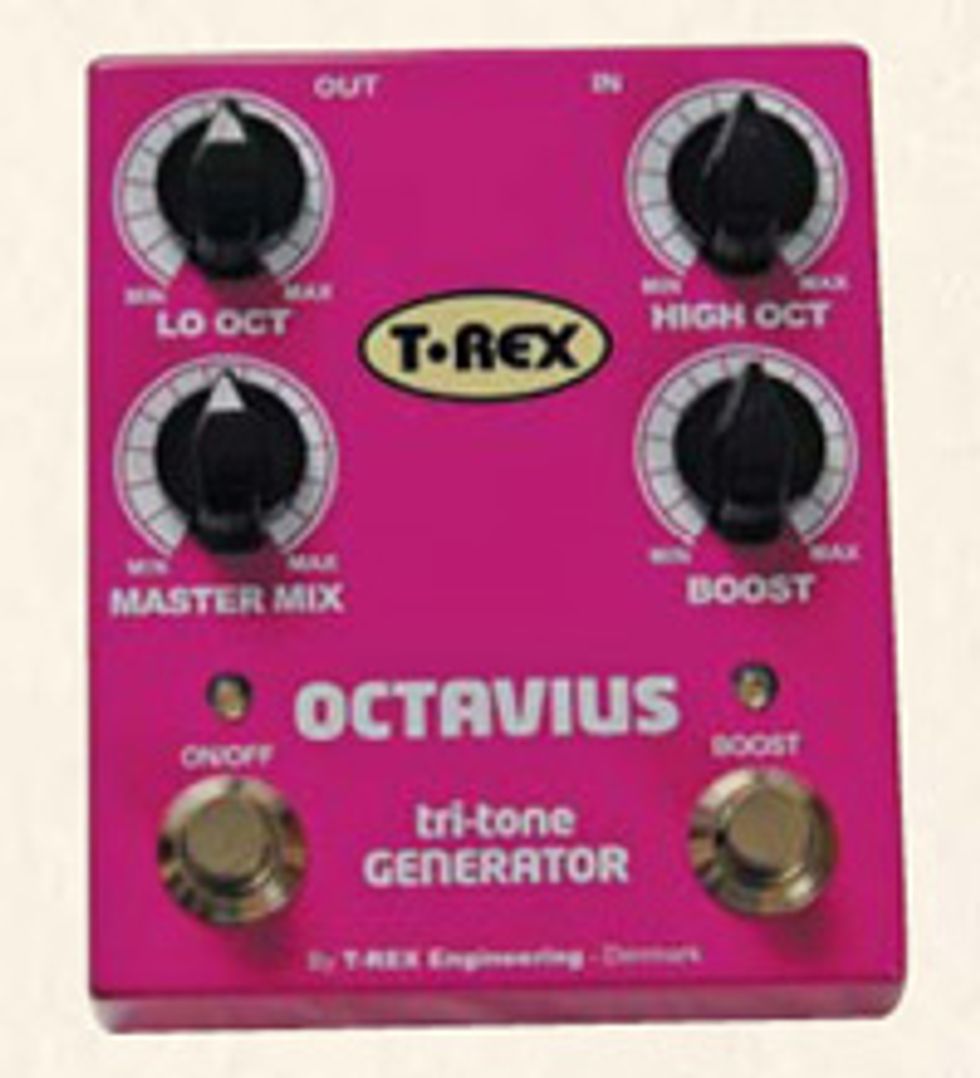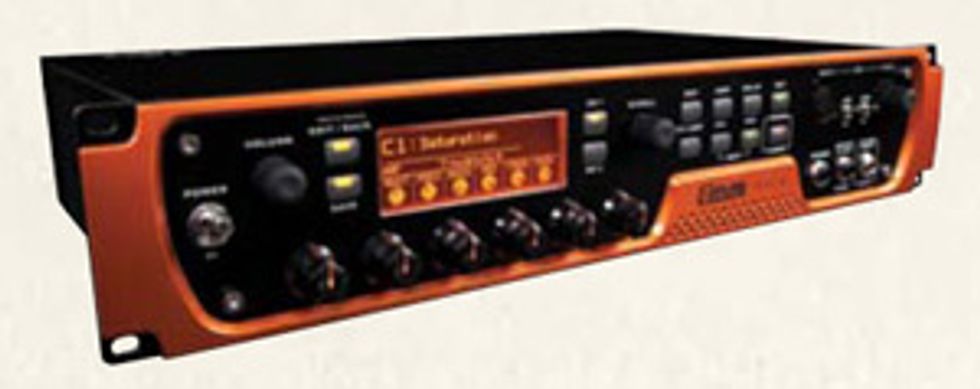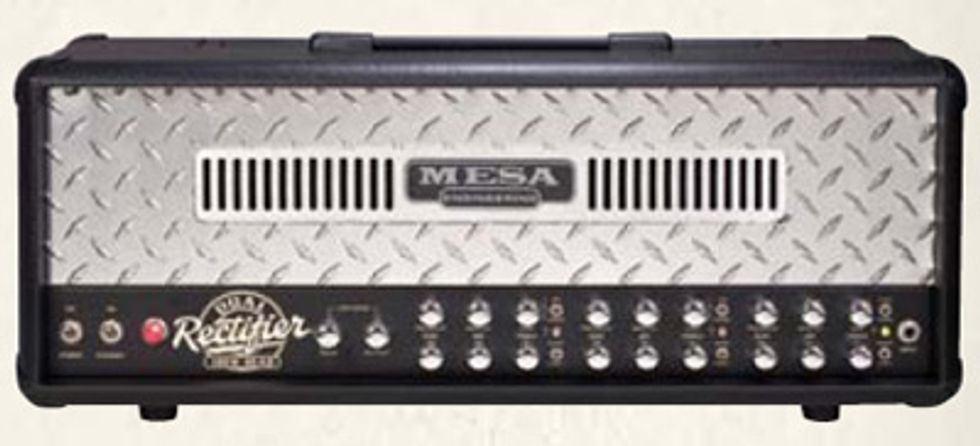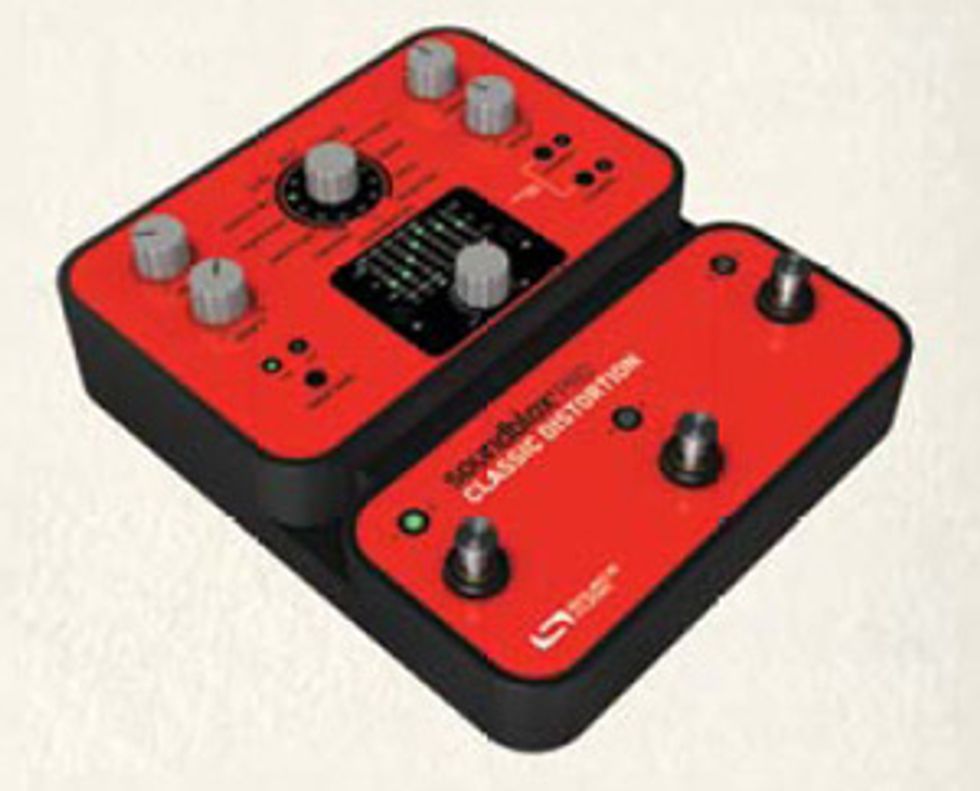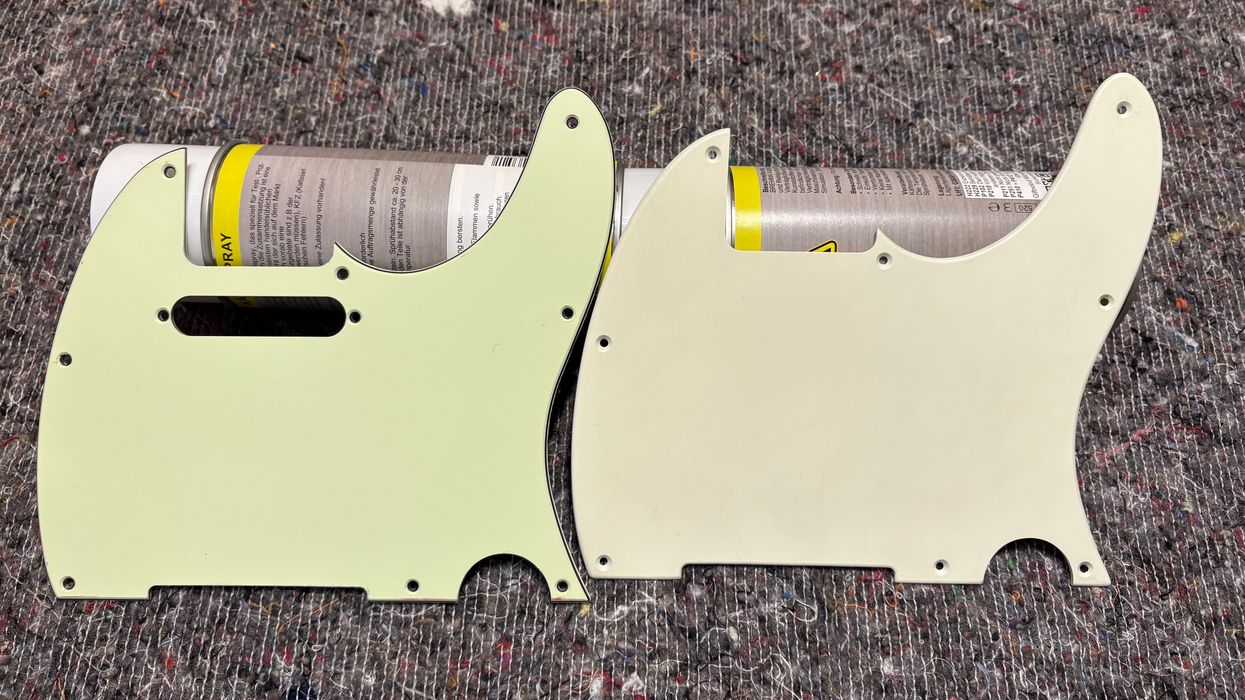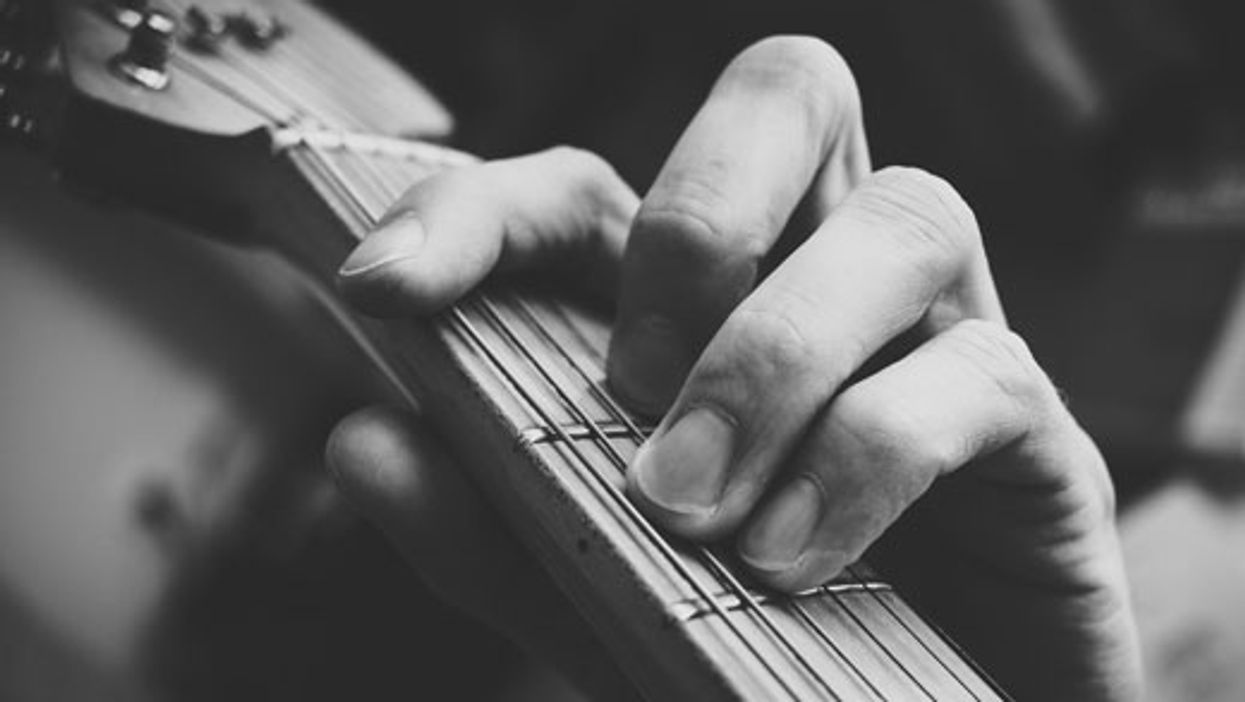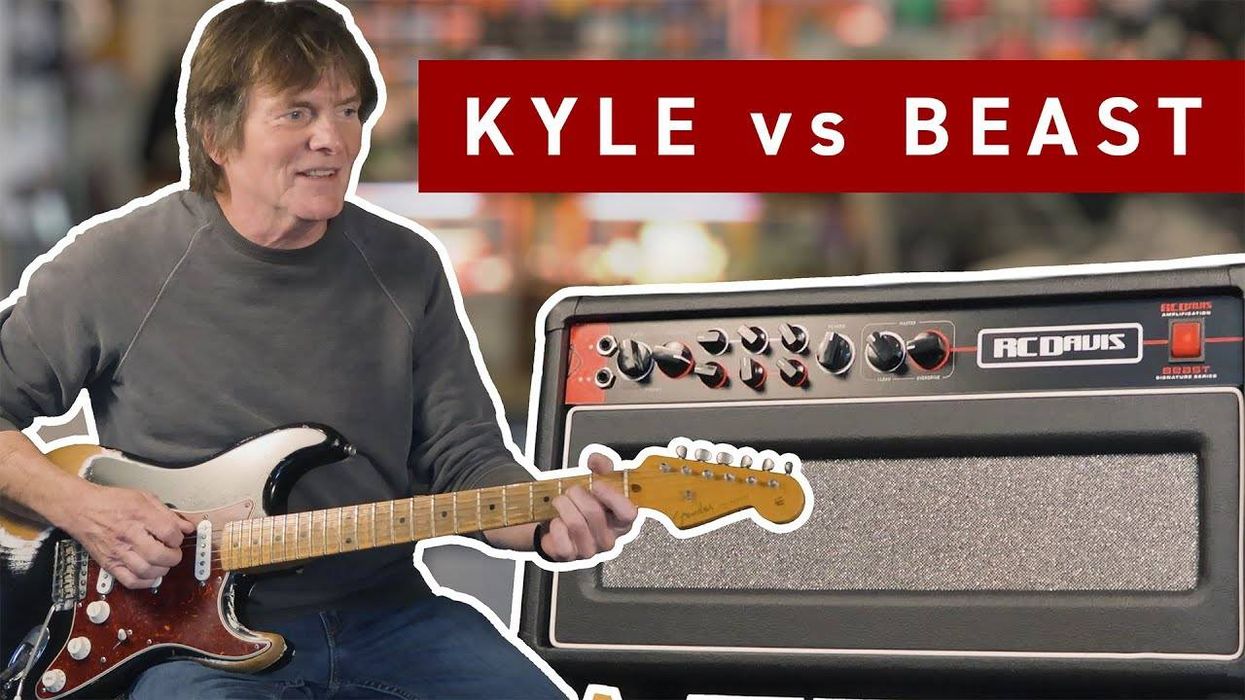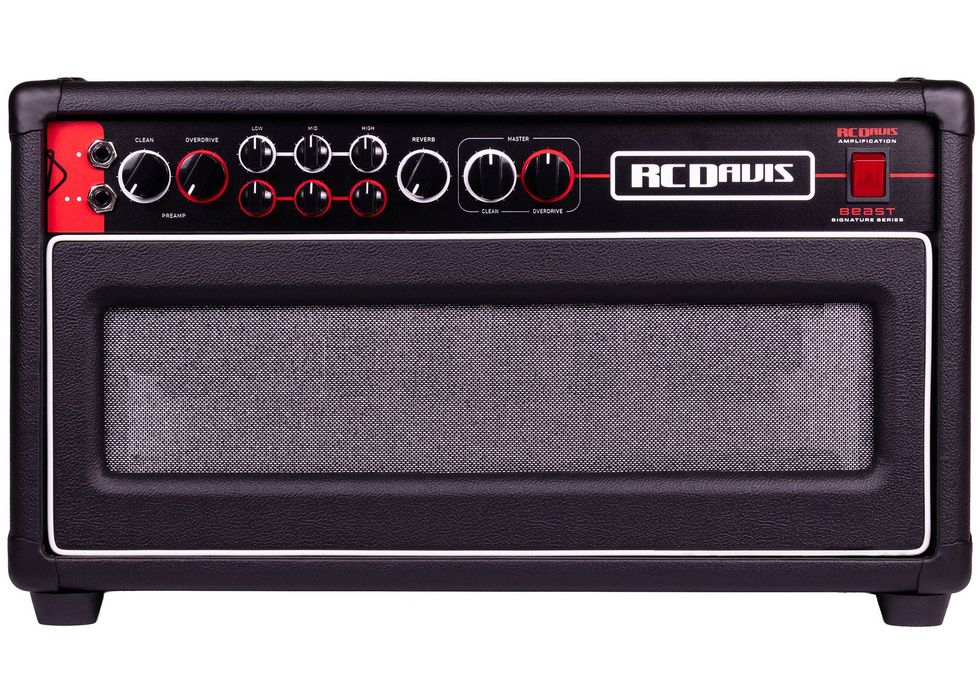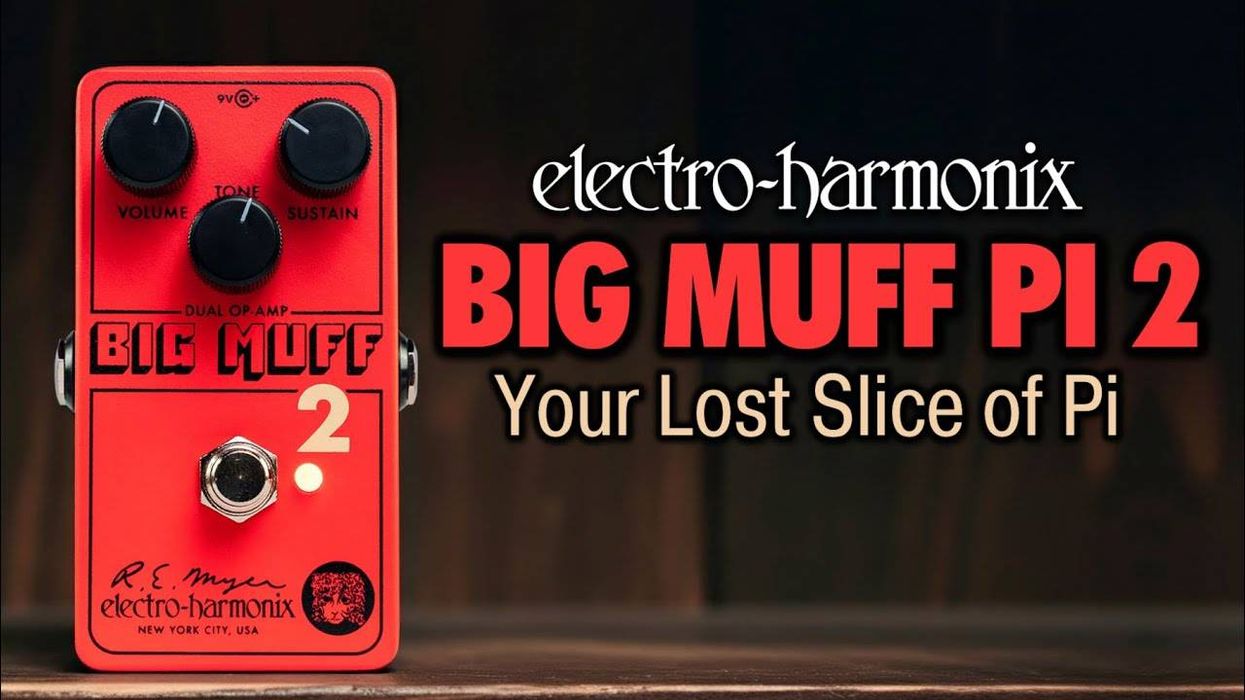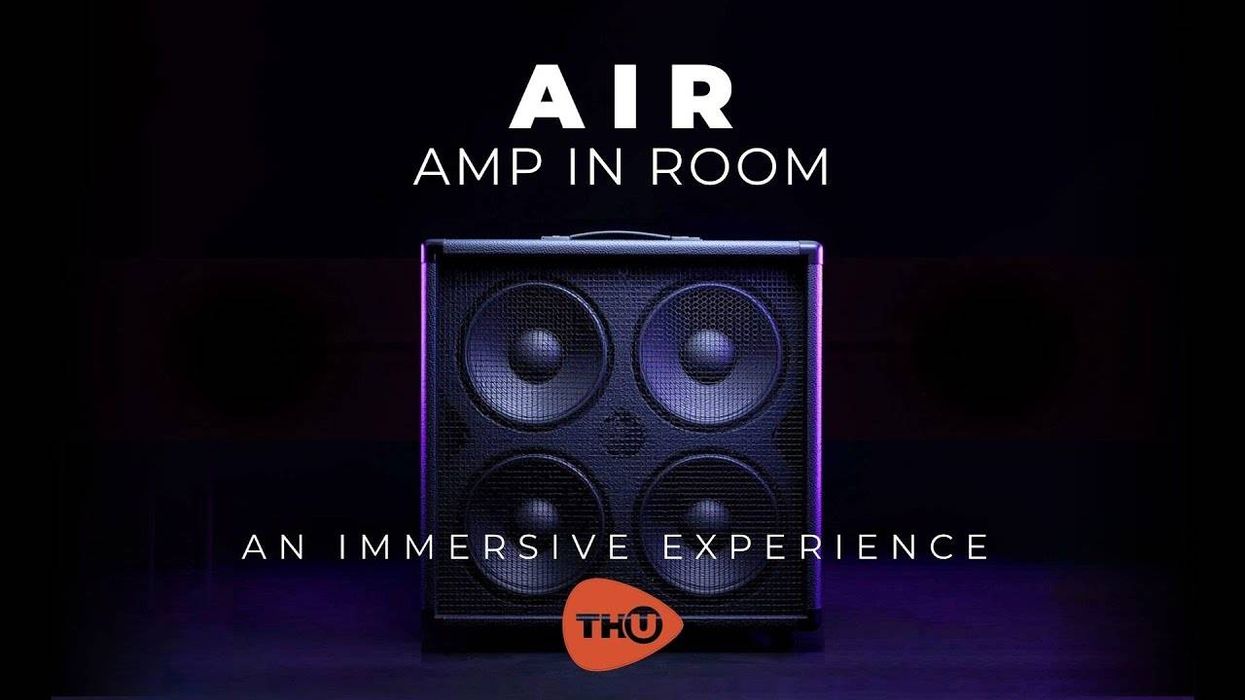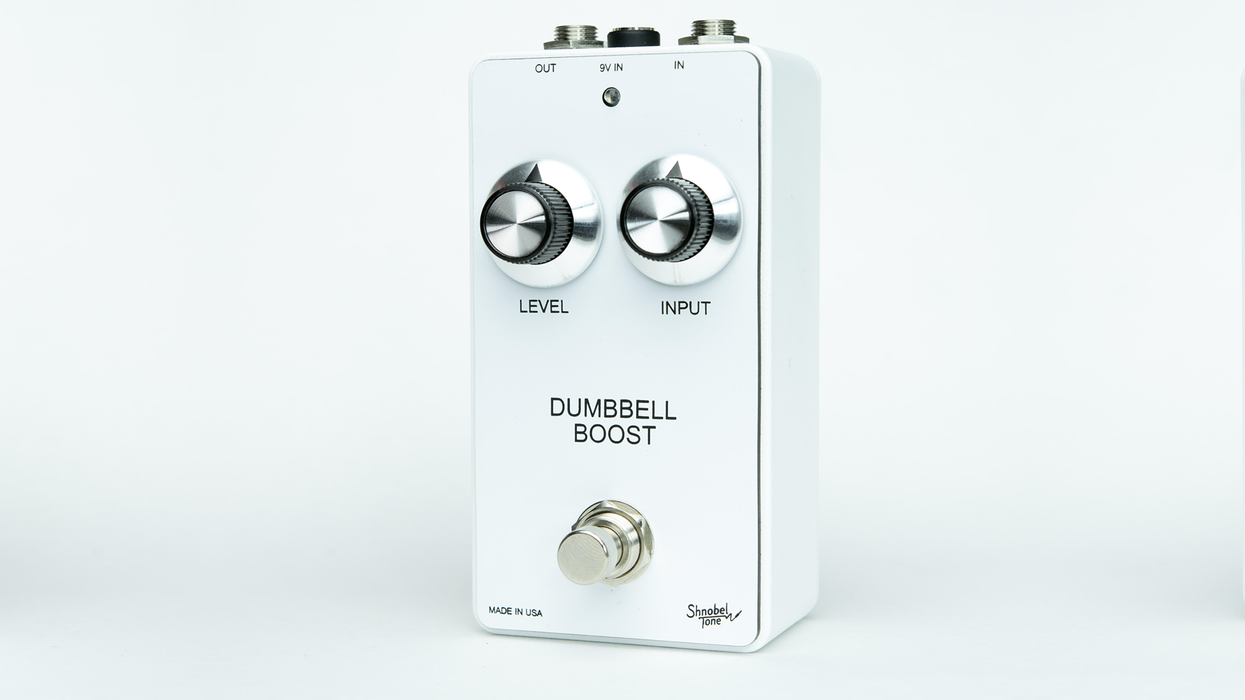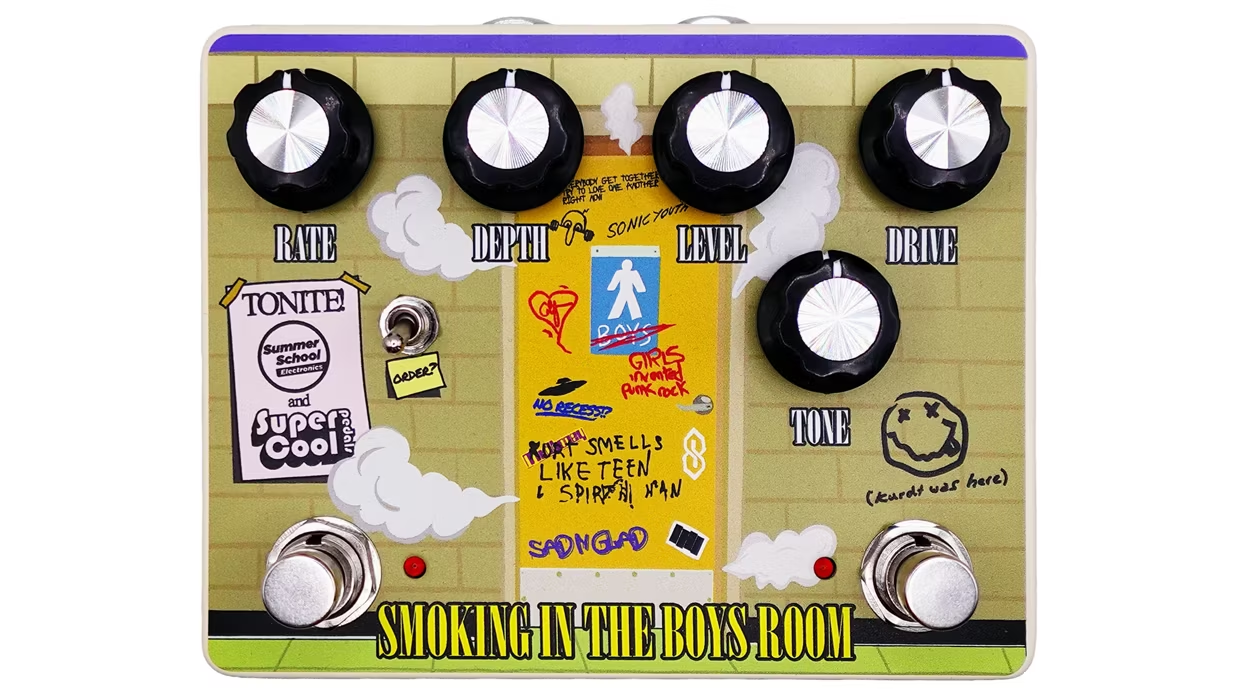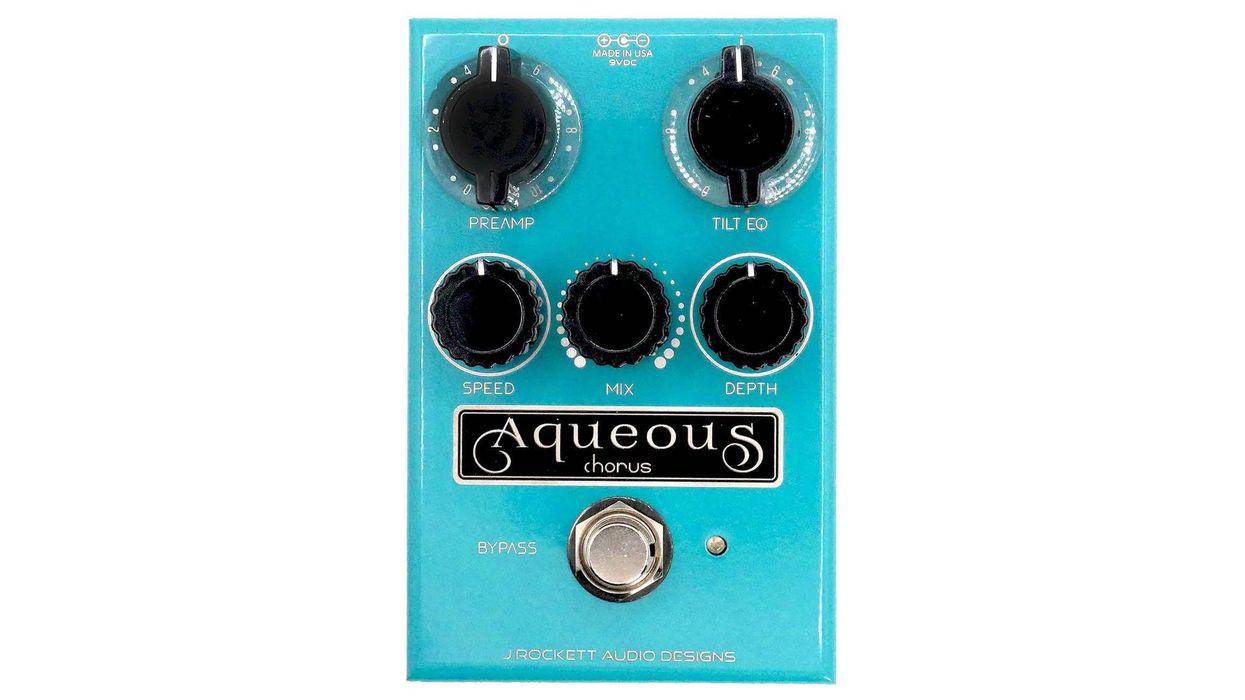As you peruse Premier Guitar gear reviews, you probably notice that just about everything we
review in these pages is pretty cool in some respect. Some things that pass through our hands,
however, are above and beyond amazing. If they don’t blow our minds or stagger us with their
beauty the minute we extract them from their case, bag, or shipping box, they knock us dead when we pick
’em or plug ’em in. These special few receive our prestigious and coveted Premier Gear Award.
The 31 products that received awards in 2010 are a wonderfully varied lot. There are some of the usual
suspects—manufacturers like Fender, Taylor, Martin, and PRS that seem to brew up an exceptionally sweet-sounding
something every year—but there are lots of new faces and little guys too. Companies like BilT,
Strymon, and Elite Tone, as well as luthiers like Jens Ritter, David Munn, and David Flammang who embody
the convergence of artistry and craftsmanship that’s possible when an individual is possessed by the drive to
create something extraordinary.
Some products, like the TC Electronic PolyTune and the Ultimate Ears 4 Pro in-ear monitors solve musical
and performance problems with a smart and practical approach, while others—like the Tone Box Skull
Crusher and BC Audio No. 7 amp—are both great sounding and positively bizarre.
What they all have in common is something of our own raison d’être—the power to unlock sounds in our
heads and fingers, and to point the way in our quest for the perfect performance, tone, or tune. We’ll be
surprised if among these prizes—which we’ve divided into five categories—you don’t find an important
piece of your own musical puzzle.
Back to Basics
Like things old school? These hot pieces of gear not only give you
access to timeless sounds, but are dead simple too—the kind of simple
that keeps you playing instead of twiddling knobs. So quit thinking
and start jamming! These tools will help you do the talkin’.
Fender ’57 Champ
Even when you’re Fender, it’s
tough to top a legend. But
sometimes coming close can
yield amazing results. That’s
certainly the case with the ’57
Champ—a reissue of one of
the mightiest little amps ever
built. While Fender Champs
of several eras might make
short lists of the best recording
amps ever, the 5-watt,
6V6-driven 5F1 circuit on which this reissue is based is treasured for
its class A circuitry and lack of negative feedback loop. In practical
terms, that gives the ’57 Champ (January 2010) an impressive combination
of low end and punch. To reviewer Bob Goffstein’s ears,
“the volume was beyond what I would expect from 5 watts.” And he
found the proprietary Weber Alnico speaker “punchy and sweet.”
Goffstein also used the ’57 Champ in the studio and for re-amping
purposes—which reminded him “why every studio needs a Champ.”
Add to all this a sweet, down-to-the-letter, period-correct, tweed-covered
cabinet and handwired circuitry, and it’s easy to see why so
many players have welcomed this little gem back with open arms.
Street $999
Jaguar Junior
The Jaguar Junior (May 2010) is an amp for folks
who like things easy.
But that doesn’t mean it
doesn’t do a lot. In fact,
the Jaguar is one of the
amps that seem to have
a little something funny
going on somewhere
behind the curtain (if we
may reference the Wizard
of Oz). It seems way louder than its 17 watts, and it’s got a much
wider sonic palette than its Master Volume, Volume, and Tone knobs
would suggest. It even has a Pentode/Triode switch that enables you
to power the amp down to 7 watts. As reviewer Pat Smith found
out, it’s got a startling amount of headroom. He was moved to note
that “set for clean, it is everything you’d want: big, fat, tight bass
response with a clear-but-not-harsh top end. Jazzers who like tubes
will really dig the Junior. The touch sensitivity is very good, and you
can get such a nice dynamic range here.” He had a lot of fun dialing
up dirtier tones with the Master Volume, and he remarked how
much tone variation could be achieved with crafty use of a guitar’s
volume knob and on the earthy distortion tones available with guitar
volume wide open. Smith described the dirty Jaguar as “classic, gritty
grind—think Billy Gibbons or George Thorogood.” Combine that with
enough clean headroom to do everything from jazz to jangle, and
you’ve got one very versatile kitty.
Street $1747
Nik Huber Krautster
Some of the most timeless and
unquestionably coolest electric guitars
ever are the dead simplest. Guitars
like the Telecaster and the Les Paul
Jr.—they don’t get any simpler. And
most attempts to improve on that
formula attempt to do so by making
matters more complex. That’s why
we love the Nik Huber Krautster (May 2010) so much. This mahogany slab of
subtle simplicity makes no apologies
for its lack of frills. And it even ups the
simplicity ante on the Tele and the Jr.
by eliminating a tone control. But that
doesn’t mean the Krautster skimps on
craft. No mein freund, this dressed-down
and mighty German is flawlessly
crafted with a gorgeous curly maple
neck that meets the body in an impeccably
designed and executed heel
joint, and it resonates like a mother
even when unplugged. It does have
one dirty little secret, and that’s a volume knob that also works as
a coil-splitter, turning the Häussel humbucker into a single-coil. An
affront to simplicity? We think not. It sounds too dang cool. Reviewer
Chris Burgess found the Krautster “extremely sensitive to touch and
playing dynamics,” and he noted that, with the Volume knob all the
way up and an amp primed with gain, the Krautster “simply shines.”
Street $2680
SkinPimp MKIII
The Mk. III Tone Bender was one of
most essential ingredients in Jimmy
Page’s early ’70s tone recipe. Like
most fuzzes of its day, it was not
a complex circuit, but its beautiful
simplicity gave shape to some
of the most iconic hooks and licks
in the rock encyclopedia. So it’s
always a surprise that there aren’t
more Mk. III clones out there—and
that makes it even more of a treat
when a really magnificent one like the SkinPimp MKIII (February 2010)
comes along. While the Skin Pimp MKIII yields access to the sounds
that sent Zeppelin aloft, there’s also a 3-way Frequency toggle that
helps tailor the MK III for more contemporary distortion settings.
MKIII tester Jordan Wagner used the toggle to “dial in some of the
most fantastic, midrange-heavy fuzz this side of Master of Reality.”
Needless to say, Wagner also found the MKIII capable of the classic
snarl that makes vintage pedal junkies seek out the original Mk. III.
He remarked on the note articulation, raspy bite, and “one of the
best vintage Jimmy Page tones I’ve ever come across, including that
sharp bite Page had in his pick attack that is so elusive in fuzz pedals
of today.” A whole lotta love, indeed.
Street $250
skinpimp-handcrafted.com
Next-Level Innovators
For those of us that see the guitar as a tool—or a blank canvas—of
limitless possibility, it’s heartening to see there are still thirsty creators,
inventors, and mad scientists bending, stretching, pushing, and
sometimes breaking the design and technology envelope. And in
some cases, these outside-the-box thinkers may change the way we
play forever.
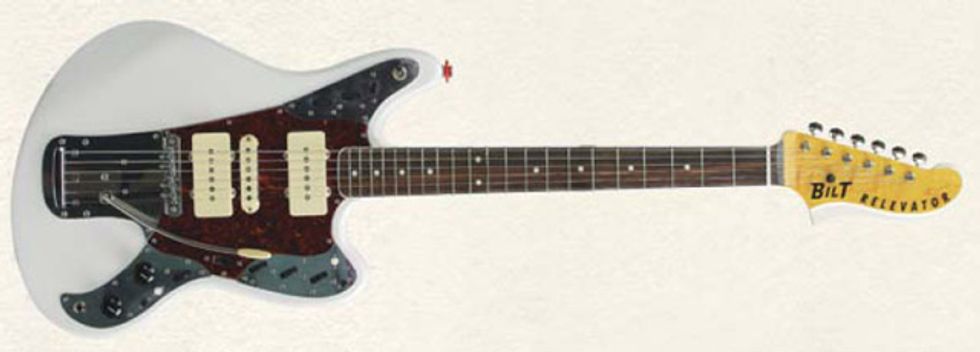
The ’60s were awash with exciting,
bizarre new guitar gadgetry.
And the drive to build a guitar that
could do it all was a bug that bit
even the most legendary builders.
Fender was no exception. And
though Leo never lost his noodle
in the manner of the mad scientists
at Tiesco Del Rey or Vox, he did
have his Marauder—a guitar much
too laden with contraptions (by
Fender standards, at least) to ever
see the light of day. Amazingly, BilT
Guitars has helped realize that most
radical expression of Leo’s vision
in a most practical way in the form
of the Relevator (December 2009 web exclusive), a Frankensteinian
amalgam of Jaguar, Jazzmaster,
Marauder, and Starcaster designs,
with a touch of Swiss Army knife
versatility a la Vox’s Starstreamer. In
fact, there’s not a lot the Relevator
won’t do. With built-in delay, fuzz,
and modulation (the latter two
can be pretty radically tailored
by trim pots that supplement the standard controls), it lets you
explore textures from the subtle to the insane. And the Relevator
is packed with top-quality components like a Mastery bridge and
Duncan Antiquity Jaguar and Jazzmaster pickups that enhance
playability. Reviewer Chris Burgess summed up his experience
with the Revelator thusly: “I can’t even speculate on how many
hours the Relevator has taken from me; it matters little, since I
was blissfully unaware of them passing, and I wouldn’t ask for
even five minutes back.” With all the gizmos this guitar packs, it’s
not like he had a choice.
MSRP $2200 (as reviewed)
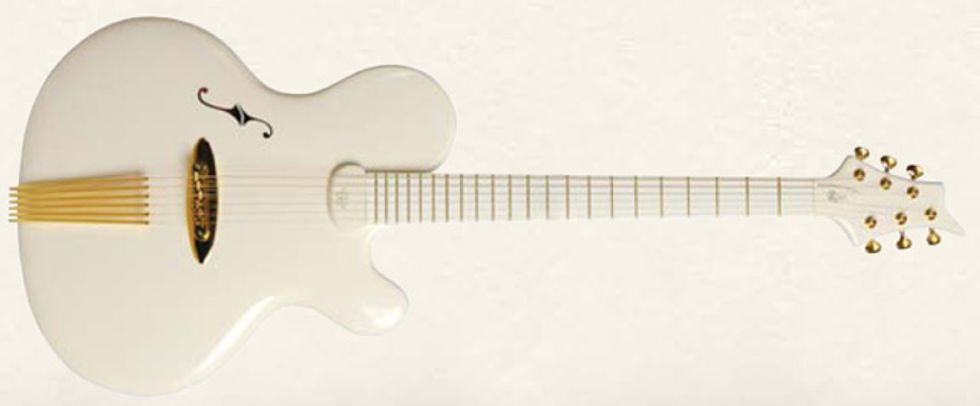
First things first: This Jens Ritter
Princess Isabella Baritone is one
rare bird. But scarcity is far from
the only thing that makes this
guitar a treasure. The Princess
Isabella (June 2010) embodies
the vast design potential
of the electric guitar, the sonic
possibilities of odd-scale instruments,
and what you can achieve
when you think of a solidbody
guitar as sculpture. Few things
about the Isabella are what you’d
expect. The body is exceptionally
thin—about an inch thick—which
means the f-hole isn’t an f-hole
at all. There’s a tailpiece that’s
gold-plated by a German jeweler,
a Häussel pickup that uses
rare-earth magnets to achieve its
low profile, and a 24-karat gold-plated
backplate. Yeah, it’s ostentatious
and over the top, but it’s
got soul and sounds beautiful!
Reviewer Pat Smith found the
Isabella’s tone to be remarkably
organic and acoustic sounding,
noting that it has “more sustain than an archtop, but retains a seemingly
delayed attack very much like a traditional jazz guitar.” After
playing it in baritone B-to-B tuning, Smith said the super-resonant
swamp-ash body “really rattles your teeth—in the good way.” A
low-end rumbler and an exquisite jazz machine all in one. Yes, its 10
grand, but in both form and function, the Princess Isabella Baritone
is as fascinating and full of expression as a guitar can be.
Street $10,000
Moog MF-105M MIDI MuRF
Who, apart from the grumpiest
music purist, doesn’t love a
Moog? From the earliest gigantic
monster synths to the newest
Moogerfooger pedals, Bob Moog’s
creations, and those of the company
that now bears his name, have
helped create some of the most
original music ever recorded. With
the Moogerfooger MF-105M Midi
MuRf (May 2010), Moog shares the
wealth of extreme tone-tweaking
experience with guitarists again.
And for those bold enough to wade into these waters, the rewards
are bountiful—if twisted—indeed. The MF-105M Midi MuRF is a
multiple resonance filer array, which is likely alien speak to anyone
apart from dedicated synth heads. In simpler terms, the Midi MuRF
enables you to create everything from subtle, frequency-specific
modulation effects to cranium-twisting, space-time-folding LFO
effects. The MIDI capabilities—too deep to list here—enable interfacing
with sequencers, drum machines, and other MIDI devices, as
well as activation of filters if you have a pickup-to-MIDI interface.
Reviewer Brian Barr “had great fun creating everything from choppy
rhythms to resonant soundscapes” using the Midi MuRF. The worlds
you’ll create are likely limitless.
Street $459
Strymon El Capistan dTape Echo
The bias against digital stompboxes has
faded in recent years. But the Strymon
El Capistan (November 2010) may have
what it takes to knock down the very
last bricks in that wall of resistance. It
ambitiously attempts to deliver every
possible permutation of sound that you
could get out of an old analog tape
echo machine—from the aural irregularities
and glorious signal degradation to
the quirks of multiple playback heads—
in a single DSP-based stompbox. And the extent to which it succeeds
is amazing. One of the beautiful things about the El Capistan is that it
emulates the analog charms of tape echoes and gives players access
to crystalline digital delay colors with equal aplomb. And it enables
variations on the two that are damn near otherworldly. You could spend
years exploring the El Capistan and never uncover every flavor of delay
within. In comparing the El Capistan with a vintage version of the legendary
Roland Space Echo, reviewer Jordan Wagner found that “the
pedal’s feel, response, and overall tone were often every bit as musical
and organic as its venerable ancestor.” He also discovered that when
he “needed a little more clarity to go with the irregularities and character,
the El Cap delivered in ways the Space Echo could not approach.”
If this pedal doesn’t sell you on what DSP can do, we don’t know what
will. But for the open-minded, the El Capistan might just extend their
playing voice to an intergalactic level.
Street $299
TC Electronic PolyTune
Beyond making sure a tuner works
accurately and is legible in performance
conditions, few of us give much thought
to that unremarkable but indispensible
box at the head of our pedalboard. It’s
safe to assume that even fewer of us sit
around waiting for a minor revolution in
tuning pedals. But players of all stripes
sat up and took notice this year when
TC Electronic delivered the PolyTune
(April 2010). If you’ve never been jazzed
about a tuner, this little number will likely change that. What makes the
PolyTune different are its polyphonic capabilities. It can detect pitch for
all six strings—simultaneously—as well as display whether they’re flat or
sharp and register your corrections on the fly with an automatic switch
to monophonic or single-string mode. For anyone who has ever heard
their tuning go sour on stage and not been certain of the culprit, the
PolyTune has the potential to save a lot of time and embarrassment.
And while, for now, it only works in standard tuning (which can be transposed
down by as much as a fourth to accommodate dropped and B-B
baritone tunings), the PolyTune has already drastically changed the way
many players tune onstage—and its USB port enables you to download
future software updates (including new tuning compatibilities) from TC.
Street $99
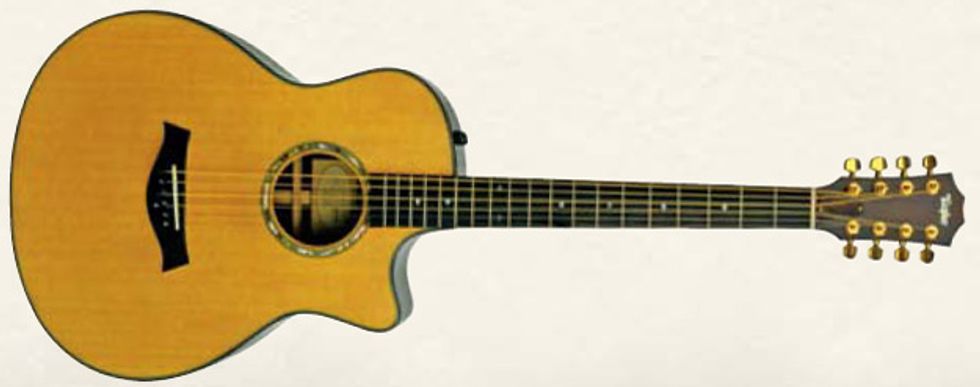
One of Taylor’s first big breakthroughs
came via the magic of octave strings,
most specifically when Neil Young took
the stage on his well-documented Rust
Never Sleeps tour with a 12-string
from the then-new company. So it’s no
surprise that, three-plus decades later,
the little San Diego luthierie outfit that
became a guitar industry giant is still
dabbling with the expressive potential
of octave strings. And with the 8-String
Baritone (January 2010)—which features
octaves on just the third and fourth
strings—Taylor proves they’re still willing
to dabble with unconventional instruments.
Gayla Drake Paul, despite having
a declared reticence to fool with the
extra-long scale of a baritone, found it
“extremely ergonomic” and even “cuddly.”
And predictably, this big Taylor
turned out to be a harmonic-hurling
tone monster. Paul found that flatpicking
brought out “a lovely, warm-but-shiny sound, like polished gold
at sunset,” and that fingerstyle work could be easily colored with
octave accents without overpowering a tune. Most of all, Paul found
the Taylor 8-String Baritone “endlessly inspiring.” And what more
could any of us ask from a guitar, no matter how many strings?
Street $3199
Refined And Luxurious
Call them sublime. Masterful. These are pieces of gear that ooze excellence
in the categories of craft, execution, and performance. They’re
either put together like the Parthenon, sound like the gods singing
from Mt. Olympus, or leave us shaking our heads at their engineering
brilliance. And they’re the kind of gear you end up being unable to live
without or insist on taking to the grave!
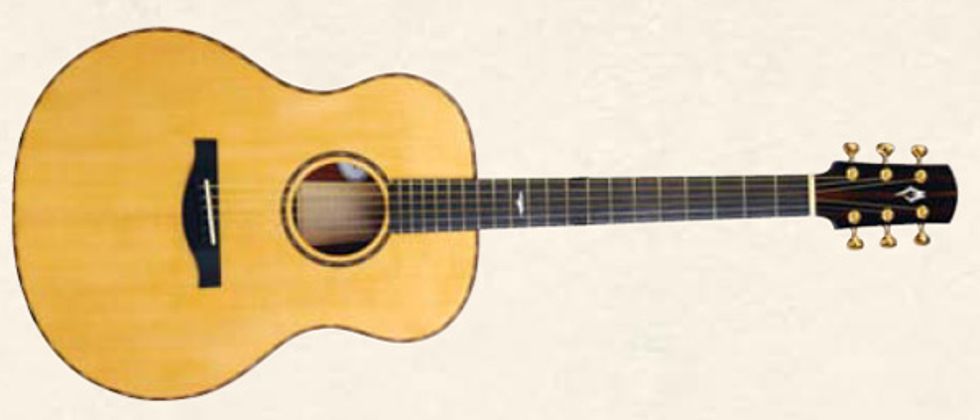
“Small jumbo?” you ask incredulously. We say, “Who cares what you
call it when it sounds this good?” Dimensions (and related puns)
aside, this latest work from David Munn’s shop is a beautiful convergence
of gorgeous tonewoods (padauk and Sitka spruce) and
playability-enhancing design—most notably a Manzer wedge that
makes this big-bodied 6-string much
more comfortable to play. Gayla Drake
Paul was understandably effusive when
it came to describing her playing experience
with the Small Jumbo (July 2010).
She found it “brilliantly velvety and
shimmeringly warm,” adding “this guitar
takes my breath away every time I pick it
up. It has fantastic low end. There’s bass
to burn, but it’s so clean—there’s not a
bit of mud to be found.” Smooth and
balanced, the Small Jumbo proved ideal
for recording. And Paul found it equally
suited for alternate-tuning fingerstyle
work or strumming. So, with this much
tone and versatility, does it really matter
what oxymoronic moniker it bears?
Street $3200
dmunnguitars.com
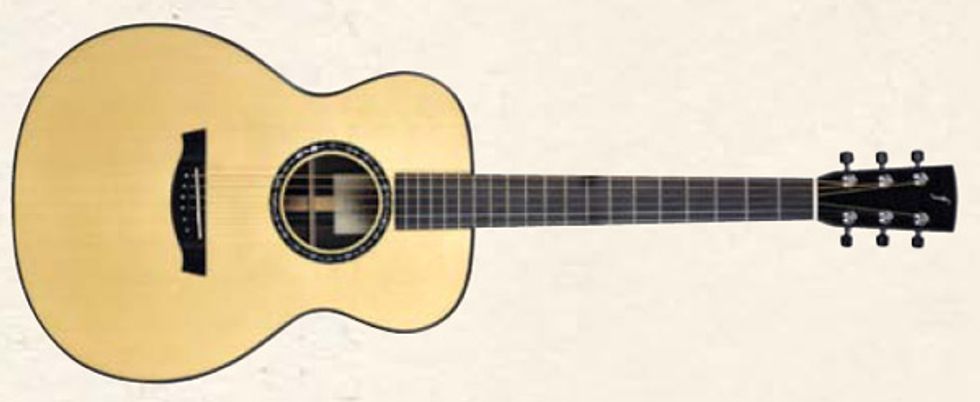
Sometimes there’s just no purer
embodiment of guitar art than a beautiful,
well-built, perfectly proportioned
acoustic. And that’s certainly what we
got in the Flammang Grand Concert
(March 2010), an elegant and understated
Carpathian Spruce and Brazilian
rosewood beauty that sounded like a
slice of heaven. Gayla Drake Paul was
bowled over by her experience of playing
the Flammang, saying “this is what
guitars are supposed to sound like:
rich and brilliant, full and warm with no
nasal midrange, and no mushy, muddy
bottom end. Just play an open chord,
like an Em7, and let it go.” And while
the Flammang Grand Concert is most
likely intended for fingerstylists, Paul
found it to be a great vehicle for flatpicking,
as well as an even-voiced tone
machine tailor-made for the microscope
of the recording studio—and free
of “crunchy or snotty overtones” or
“unmanageable boominess.”
MSRP $7900 (as reviewed)
Jetter Jetdrive Dual OD
With a lot of low- to medium-gain overdrives on the market, it’s
not unusual to feel like you’ve got limited options. Not so with the
dual-channel Jetter Jetdrive Dual OD (December 2009 web exclusive),
which offers up a truly impressive palette of OD hues, superior
responsiveness, and transparency that lets your amp do the things
it does best. The Jetdrive’s two basic channels—the 6V6-ish “Blue”
channel and the more Anglo-sounding “Green” channel—offer
two distinct worlds of overdrive to work with. But with the capacity
for one channel to drive the other
(depending on which gain knob you
set higher) and channel-specific Tone
controls that can be used together
for even more complex blends, the
Jetdrive easily inhabits tonal territory
all its own. Reviewer Michael Ross
found that “sustained single-note
bends bloomed into the kind of high
harmonic found only in the best boutique amps,” and that humbuckers
used with the blue channel “sent it to fat-city, without a trace of
mud.” Ross summed things up by calling the Jetdrive a “two-channel
boutique in a pedal.”
Street $249
L.R. Baggs Anthem Tru-Mic Pickup System
Reviewer Gayla Drake Paul calls this
dual-source acoustic system “a truly
giant leap forward” for those who
want their great-sounding acoustics to
sound amazing even at ungodly stage
volumes. Find out what sets it apart in
this month’s full review.
Street $299
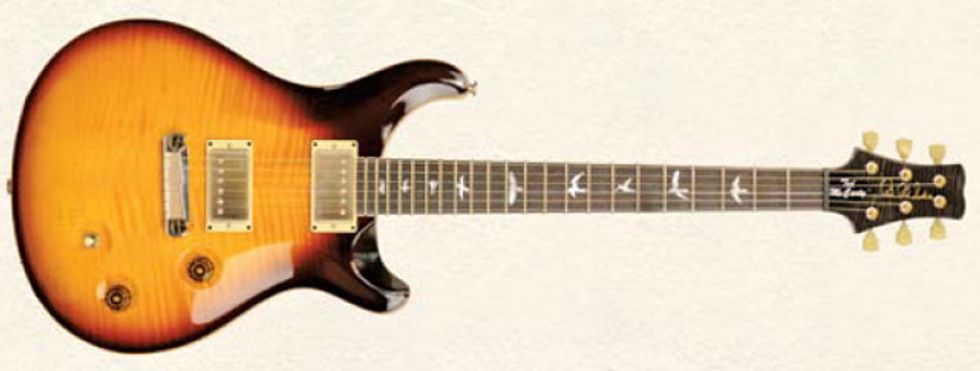
PRS Ted McCarty DC 245 Limited Run
It’s probably not a stunner to see a PRS
McCarty among our Premier Gear award
winners. After all, it’s a guitar that a gazillion
players have lusted after since the
model debuted in 1994. In its DC 245
Limited Run incarnation, however, the
McCarty is outfitted with the company’s
much-lauded 57/08 pickups, vintage-inspired
aesthetic touches (like brushed-nickel
pickup covers and an understated,
slightly aged-looking smokeburst finish),
and fancy touches (like bird inlays) that
Smith incorporated as a special tribute
to Ted McCarty, the former Gibson
president and design pioneer. Reviewer
Jordan Wagner couldn’t find enough
ways to praise the 57/08 pickups, calling
them “utterly fantastic.” Over the
course of evaluating the McCarty (April 2010 web exclusive), Wagner found that
“midrange response from the pickups is
very soft, but each frequency is audible
and discernable, making them rather difficult
to muddy up. Combined with tight,
blooming lows and a very unique, singing high end, the whole package
is just extraordinary.” And in the end, Wagner called the McCarty
DC245 Limited an “extraordinary tribute from one visionary to another.”
Street $3395
Real McCoy Custom RMC8-Guitar Eqwahlyzer
Brad Plunkett’s mid-’60s design
for the Italian Vox Clyde McCoy
is widely regarded as one of the
greatest wah circuits. And for
many pedal makers, building a fair
emulation of that iconic stomper
would have been a major accomplishment.
But Geoffrey Teese,
the man behind Real McCoy
Custom wahs, has always had the
will and wizardry to constructively
tinker with classic wah sounds.
And the RMC8-Guitar Eqwahlyzer
(November 2010) does a beautiful
job of delivering the much-loved Plunkett/Clyde McCoy flavor, with
equalization capabilities that enable you to customize the voice to your
rig and style. The versatility doesn’t stop there, either. A toggle switch
allows you to switch the sweep contour between a NOS Icar-taper pot
and an expanded-range taper that’s reminiscent of an aged Icar-taper
ROC-POT 5.2 wah pot. Reviewer Steve Ouimette loved the way the
controls enabled him to modify the wah’s tone to better suit humbuckers,
P-90s, and single-coils. And he remarked, “no matter what combination
of guitars and amps I used, the RMC8 delivered in spades. The
tone was always lush, the sweep was smooth and free of scratchiness,
and the sonic flexibility was nearly unlimited. It can be easy to grow
weary of a wah when it’s a one-trick pony. But there’s almost no end to
what the RMC8 can deliver.”
Street $269
Ultimate Ears 4 Pro Series Custom Monitors
Few performing musicians—even seasoned
pros—warm up to in-ear monitors right off
the bat. No matter how muddy a stage mix
is, the same in-ear-monitor mix will usually
sound—and feel—weirder. But as our
reviewer John Bohlinger found, Ultimate
Ears 4 Pro in-ear monitors (January 2010)
are, how shall we put it . . . unnaturally
natural. Bohlinger performed with the
Ultimate Ears 4 Pro in settings including
an open-air festival, an intermediate-sized
club, and a recording studio, and he found them superior to wedge
monitors or headphones in every instance. According to Bohlinger,
had he “started with the UE 4 Pros, I would’ve stopped right there
and saved myself lots of money and aggravation.” With everyone
from the Rolling Stones to Van Halen in agreement, maybe we’ll have
to start imagining a world without wedges.
Street $399
Tried And True—With a Twist
There are a lot of ideas in the gear world that just plain work—and
always will. The sounds they make are all but hardwired into our
musical memories and subconscious, often because of how intricately
they’re intertwined with classic songs and the tones of our heroes.
But even the best ideas leave room for refinement, evolution, or
variation. Each item in this category of Premier Gear winners bravely
attempts to add something extra to these totems of great guitar
thinking. And in every instance, they’ve gotten something really right.
3 Monkeys Grease Monkey
The 30-watt Grease
Monkey (December 2009 web exclusive) is powered
by four EL84 tubes and
serves up a British flavor
that’s truly gargantuan.
Reviewer Gary Guzman
noted that the Grease
Monkey might have more accurately been called King Kong for
its massive output. He also called it a “tonal monster,” noting its
“extreme touch sensitivity and dynamic range.” Players that gravitate
toward bare-bones amps will love the Monkey’s simple control set,
which features Cut and Shape controls that enable a little more roar
than an AC30 and a little more clean headroom than a Marshall. The
Grease Monkey is one of the cooler-looking amps we’ve seen around
the PG offices, too.
Street $2250
BC Audio Amplifier No. 7
You can pack a lot of stuff
in an ammunition box—your
baseball card collection, your
guitar cables, and a couple
stompboxes. But an amplifier?
Naturally, there’s a lot more
to Bruce Clement’s ammo box
amp, dubbed the No. 7, than
visual gimmicks. Reviewer Steve Ouimette found that the 15-watt,
point-to-point-wired, 6V6-powered No. 7 (January 2010) had an
exceedingly unique voice that sounded much more akin to an AC30
or a baby Marshall Super Lead than a 6V6-driven amp. He found
headroom aplenty by simply rolling off his guitar’s tone control, but
he was also able to drive the amp to saturated, Hendrixian heights by
setting the amp’s controls to the max. Ouimette also found the BC
No. 7 exceedingly pedal friendly when he ran octave dividers, fuzzes,
and distortion boxes through it. “It’s like having a handful of your
favorite classic tube amps at your fingertips but still hearing something
new and fresh. This is an amp that you can play for hours and
never get bored with.” Pass the ammo!
Street $1795
Creation Audio Labs Holy Fire
Tired of overdrives that suck tone and shrink the sound of your
guitar and amp? The Holy Fire (April 2010) might just be the fix.
Reviewer Steve Ouimette found it to be capable of tones ranging
from warm and subtle overdrive to brutal fuzz perfect for wall-shaking
stoner rock. But Ouimette also found that the Holy Fire
never diminished bass response in
return for high gain. He also found
the Holy Fire to be exceedingly
clean, remarking “the overdrive
sound is thick without being muddy,
and you can bring it up to the highest
settings without adding significant
noise. In fact, this pedal has
got to be the quietest OD pedal
I’ve ever heard.” Ouimette surmised
that part of the Holy Fire’s quiet and fiery magic is attributable to
the 48-volt power supply that comes with the box. But whether he
was using it for thick gain or subtle overdrive, Ouimette found that
the Holy Fire had a “unique ability to bring the best out of your
guitar and amp.”
Street $195
Elite Tone Fillmore Thunder
As legendary as the original
Octavia octave fuzz is—especially
to Hendrix disciples—it’s not a
widely or readily understood
effect. It’s a little bit hairy, alien,
and random, which of course is
why Jimi loved it—and why so
few players in search of Jimi’s
tone ever master it. The Fillmore
Thunder (May 2010 web exclusive),
a beautiful Octavia-style circuit
from Elite Tone may not be much easier to get your head around,
but a player with the patience to unlock this pedal’s many capabilities
will find a wealth of Octavia tones that evoke Jimi’s sickest octave
tones—and realms beyond, too. A Bias knob helps players dial in a
less-compressed distortion than original Octavias, and a Gain control
makes it easier to tailor the pedal to your guitar’s output. Together,
they make the Fillmore Thunder a more expansive and capable take
on the Octavia sound. Reviewer Kenny Rardin took this praise a step
further, calling the Fillmore Thunder “the most controllable Octavia
I’ve ever played.” He cited the unit’s exceptional flexibility, too, noting
that “usually Octavias are used on the neck pickup and above the
seventh fret; this one tracks well throughout the fingerboard and even
works well on the bridge pickup.” Sounds to us like a true evolution
of a revolutionary and timeless effect.
Street $177
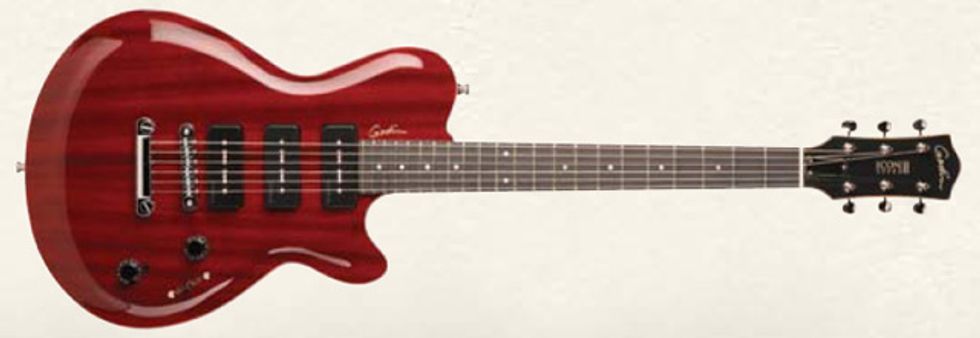
Godin ICON Type 3
Godin has always packed a lot of value into their guitars, but the
ICON Type 3—with its Lollar P-90s, rock-solid and super-clean
construction, and clever High Definition Revoicer (H.D.R.) active-to-passive switching capability—is one of the most value-packed
6-strings we’ve seen in a long time. For starters, it’s a looker. It
features a simple, elegantly sculpted mahogany body that steps
off from Gibson design territory but employs an offset waist and
smooth top carve to claim an aesthetic all its own. The chambered
body also makes the guitar light and extremely comfortable to
hold. Reviewer Gary Guzman found
that the H.D.R. gave the ICON Type 3
(November 2010) greater punch and
responsiveness in many situations and
added presence and brilliance when
needed. But he also found the simple
combination of the Godin and the
Lollar pickups a perfect match. “With
or without the H.D.R., the Lollar P-90s
had me hooked with their balance of
midrange, clarity, and warmth. These
pickups inhabit an ideal sonic space
that’s brighter than a humbucker, yet
has a fatter, thicker tone than a traditional
single-coil that breaks up very
smoothly with distortion.”
Street $1395
Kilpatrick Audio Vibro Man
Canada’s Kilpatrick Audio knows how to
pack a lot of tricks into a single pedal. But
few pedals by any manufacturer come close
to packing as many truly useful and expressive
tricks as the Kilpatrick Vibro Man modulation
pedal (March 2010). Its ingenious circuit
gives you not just delicious vibrato and
tremolo effects, but also a vibrating bandpass
filter that can be used in conjunction
with the tremolo to produce mind-bending
modulation madness. With such deliciously
twisted modulations, it only makes sense
that the Vibro Man also enables you to send your signal out in stereo
for warped synchronization effects. It also includes a Touch switch
that accentuates a given effect the harder you play. Reviewer Jordan
Wagner said using the Tremolo and Vibrato together produced some
of the coolest modulation effects he’d ever heard, noting that the
Tremolo occupied a modulation sweet spot that was “not too soft,
but certainly not too choppy.” But what impressed him most was the
Vibro Man’s range: From subtle to seasick wobbly, its tones make it a
“multi-function modulation powerhouse.”
Street $249
Lovepedal RedHead
Sometimes it seems tonehounds spend
their whole lives trying to clean up their
dirty tone. Fair enough. But sometimes we
like our dirty a little more wild. That’s where
the Lovepedal RedHead (September 2010 web exclusive) comes in. Steve Ouimette
used the word “irreverent” to describe this
pedal’s fiery voice. He also invoked the
name of Billy Gibbons, a virtual patron saint
of grease, sleaze, and attitude, as someone
who would adore the RedHead’s snarling
and delightfully boxy tone. In more aggressive settings, Ouimette used the RedHead to summon controlled
harmonic feedback and create a bed for more Gibbon’s-like pinched-harmonic
effects. Ouimette found the tone control very flexible and
useful for adding bite and presence. He also found the RedHead to
be the ticket for kicking his Stratocaster and Marshall into amp-blowing
Blackmore territory, declaring with glee that the RedHead served
up “the thickest, most badass attack I’d heard through my Marshall in
years . . . the sound of the amp acting like it was going to give way
at any second.” He also gave the RedHead what we consider high
praise (at least when we’re in a dirty mood) when he emphatically
declared, “This is not a subtle pedal!”
Street $199
Martin OMC-LJ Pro Laurence
Juber Custom Artist Edition
Martin’s OM is one of the greatest
acoustic fingerstyle guitars ever
designed—heck, it’s just about one of
the greatest guitars period. And former
Wings and studio ace Laurence
Juber is as about as resourceful a
guitarist as you’ll ever find. So the fact
that the guitar that resulted from the
collaboration between the two should
end up a recipient of a Premier Gear
award isn’t startling. But that doesn’t
mean the OMC-LJ (January 2010 web exclusive) is lacking in surprises.
Unlike previous Martin Laurence
Juber models, the OMC-LJ Pro has
a back and sides of maple—a tonewood
that imparts a lot of warmth
and detail but is more commonly
seen on heftier, jumbo-bodied guitars.
Reviewer Gayla Drake Paul loved
the sonic qualities of the maple and it’s affect on her playing, noting that
it had “incredible power, drive, and sustain, with lean but warm bass and
plenty of sparkle. You put your hands on it and it starts to sing, and gives
up its tone effortlessly. I still haven’t found a way to overdrive it and make
it sound fuzzy or distorted.” She also found it amazingly versatile “This
guitar rocks. Or whispers. You can make it sing like an angel or bark like a
dog. You can play fingerstyle and you can flatpick. It loves open tunings,
but sounds awesome in standard tuning.”
Street $4599
Rack Systems Brown Eye and Naked
Amp builder Dave Friedman’s takes on vintage Marshall sounds are
informed by working with a very demanding clientele (among them
Jerry Cantrell and Eddie Van Halen) but also by an interest in lending
them a modern sound and feel. In the form of the 100-watt
Brown Eye and Naked heads (September 2010), Friedman took two
very bold, impressive, and successful steps toward that goal. Jordan
Wagner found the plexi-inspired Brown Eye, with its Fat, Custom 45,
and Saturation switches and Clean and Gain channels, to be the more
flexible of the two. Noting that it was capable of biting, late-’60s-
Marshall clean and
saturated tones, Wagner
remarked that “the
pure, raw aggression
lunging from the amp
was staggering, to say
the least.” The Naked,
inspired by a Friedman
modification of A
Perfect Circle guitarist
Billy Howerdel’s JMP
100, is (as the name
suggests) the more
straightforward affair. Designed for clarity, high gain, and improved
touch sensitivity, the Naked impressed Wagner with its headroom and
clean-channel tones, though it also had no problem driving into “raging
Slayer territory.” With aesthetic nods to the very earliest Marshall
heads and tones ranging from classic rock to modern metal, Friedman’s
amps cover a lot of high-power Brit amp history and sonic territory.
Brown Eye Street $3500
Naked Street $3000
T-Rex Octavius
Octave pedals can take many forms.
They don’t come in as many flavors
as fuzz boxes perhaps, but they can
run the gamut from chaotic and
rhino-grunt-belching to harmonically
precise and singing. The T-Rex
Octavius (November 2010 web exclusive) has a foot in each world.
And for having such a many-faceted
identity, it might just become the
octave pedal most likely to stay on
your pedal board. The Octavius isn’t
exclusively a dive-down or high-octave pedal. Instead, you can set
volumes for separate high- and low-octave functions, which effectively
allows you to create a three-octave tone that you can also boost for
super-fat and rich lead work or leave clean for subtle texturizing. Out
in front of a fuzz box, this thing can do major damage. But by itself
it’s an exceptionally musical pedal that can make your guitar pop in
a mix. Reviewer Oscar Jordan was able to “dial in all kinds of octave
variations, going from subtle thickening of my stock guitar tone to
crazy high-pitched stuff that sounded like my Strat suddenly becoming
a 12-string.” Looking for one pedal to totally transform your tone
vocabulary? The Octavius may be the ticket.
Street $279
Tone Box Skull Crusher Overdrive
If there’s one thing rockers like, it’s a good skull. And, frankly, were
amazed we haven’t seen a stompbox in a brain bucket before the
Skull Crusher. Thankfully, when Tone Box got around to doing this
most macabre stompbox deed, they made it sound amazing, too.
The Skull Crusher (March 2010) is the brainchild of John Kasha, an
expert on high-gain Marshall amp modifications. And as reviewer
Steve Ouimette found out, it can turn
a JCM 800 into a thick, singing beast.
Switchable voicings—including, Clear, Ice,
Chains, and Body—yield tone-shaping
and switchable-gain capabilities that
Ouimette likened to “stepping through
a very effective tone stack that revoiced
the Marshall for four totally usable and
very different tones.” A Turbo Boost
mode provides access to a super-high-gain boost full of harmonic
sustain that is tailor-made for pinched harmonics and other modes
of metallic expression. As Ouimette said, “rarely have I heard a
pedal that so effortlessly let you be heard through the din. It’s like
stepping above the band and proclaiming, ‘Here I am!’” As if having
a glowing skull on your pedal board wasn’t enough!
Street $399
Do-It-All Marvels
There’s a certain species of gearhead with a weakness for the contraption
that does everything. Not that we blame them—multi-channel
amps mean fewer pedals to haul, leave behind, or break. Multifunction
pedals lend performance versatility. And digital recording
solutions can practically stuff Abbey Road in a box. What follows are
some of the finest and most ambitious examples of Swiss Army-knife
thinking we’ve seen at PG this year.
Digidesign Eleven Rack
Anyone who’s watched
the evolution of the
electric guitar business
for very long has
watched their share of
do-everything products
come and go. But,
like the Pro Tools recording software it’s designed to work with, the
Digidesign Eleven Rack (April 2010) has the potential to be a major
game changer. The Eleven Rack is a full-featured recording interface
that works seamlessly with the included Pro Tools LE software. But
it’s also a standalone guitar-effects processor with 16 amp emulations,
seven speaker simulations, and another eight microphone
emulations. Its DSP is accelerated to eliminate latency, and it also
has an effects loop so you can through your favorite stompboxes
in the mix. The end result is a lot of creative flexibility and potential—
everything from dialing in hundreds of tones onstage to trying
countless textures while tracking. As reviewer Gary Guzman succinctly
put it, “the Eleven Rack is an all-in-one solution for the modern
guitar player, and it makes it easier than ever to record in the studio
and perform live—while fully integrating the exact same sounds in
both situations.”
Street $899
Mesa/Boogie 2010 Multi-Watt Dual Rectifier
If you’re a player who needs power and flexibility and considers a
wah very nearly one
pedal too many,
Mesa/Boogie may
have just built your
dream date. That’s
what reviewer Lyle
Zaehringer found
out when he tested
the monstrous Multi-Watt Dual Rectifier (August 2010 web exclusive)—which can operate between 50 and 100 watts, use either 6L6 or
EL34 tubes (depending on a bias-switch setting), and cover everything
from dirty Texas blues to high-gain metal. The three-channel Multi-
Watt has more tone-shaping capacity than a lot of substantial pedalboards:
Each channel features a switchable mode (Clean and Pushed
on Channel One, and Raw, Vintage, and Modern on Channel Two) and
can be set for 50- or 100-watt operation. Zaehringer found studio-ready
clean tones at lower wattages, while high-wattage Modern settings
propelled the Multi Watt into the shred zone. While players who
are new to the Rectifier interface may find the Multi-Watt has a bit of
a learning curve, Zaehringer stated that “such versatility makes the
amp a good practical buy for guitarists who prefer not to have one
amp per musical style.” And he summed up the Multi-Watt’s many
merits with: “it would be a vast understatement to say that the Dual
Rectifier is a flexible amp. It is the standard of tonal flexibility by which
its competitors are judged.”
Street $1799
Source Audio Soundblox Pro Classic Distortion
There are pedals that just make
sense for the guitarist on the go.
You know, the player who contributes
to three different projects
and uses whatever amp is lying
around the rehearsal studio or
club they’re playing that night—
the player who’s fed up with
lugging around a 10-ton pedalboard
all week. The Source Audio
Soundblox Pro Classic Distortion
(June 2010) is one of those magic back savers. It’s a digital distortion
that packs convincing emulations of legendary stompboxes—from the
Electro-Harmonix Big Muff Pi and Dallas Arbiter Fuzz Face to the Octavia
and Solasound MK II Tone Bender—into a single, easy-to-use chassis. It
also sports Tube Screamer-inspired overdrives, a clean boost section, and
a Tube Drive setting that gives you a taste of that overdriven Marshall
sound. And if all that weren’t enough fun, the Soundblox also works with
the Hot Hand motion sensor—a wireless system built around a finger ring
and an RF receiver that gives you the power to control effect parameters
with a wave of your hand. Imagine that—your quasi-Page/Hendrix gesticulations
applied to a practical musical purpose other than annoyance of
your bandmates! There’s also an optional expression pedal for switching
between presets. Reviewer Gary Guzman had a blast running through
tones as varied as Brian May-style smooth distortion to Dimebag-like
hyper gain settings and crazed Octavia settings. And no less than Adrian
Belew has deemed the Soundblox one of the best distortions ever made.
Street $219



